






For more benefits, ask your local wholesaler or visit www.chemfax.com or duboischemicals.com Try Chem-Frost
Safe for all systems (including aluminum and solar)
Premier inhibitors
Higher temperature rated
Phosphate and nitrate free
Low viscosity










For more benefits, ask your local wholesaler or visit www.chemfax.com or duboischemicals.com Try Chem-Frost
Safe for all systems (including aluminum and solar)
Premier inhibitors
Higher temperature rated
Phosphate and nitrate free
Low viscosity


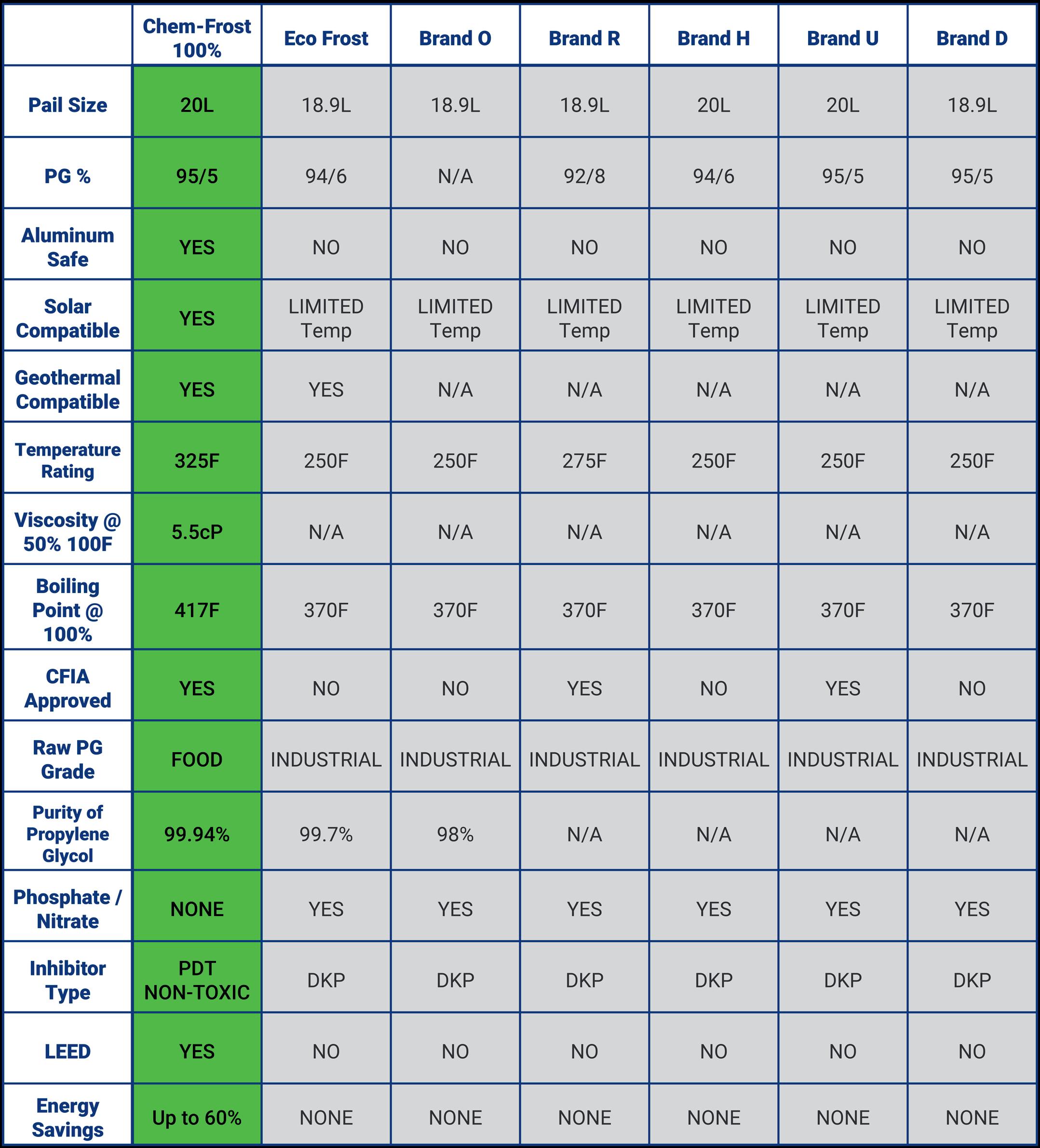
Based on information provided on respective manufacturers’ websites*
**Subject to change**



HYDRONICS
ELEVATING THE INDUSTRY
The eighth edition of the Modern Hydronics Summit delivered education and excitement. By HPAC Staff
20 COVER STORY
SWEET HEAT
BRINGING THE HEAT
Three winning projects in the fourth annual HPAC Magazine Sweet Heat Awards reveal variety and ingenuity in hydronic system designs. By Doug Picklyk
29
HYDRONICS
SOLAR EQUALS DHW PLUS MORE
There are still viable applications for solar thermal technology. By John Siegenthaler
34
SOLAR THERMAL SOLAR GAIN
More reasons to reconsider embracing solar thermal for heating the water in our buildings. By Curtis Bennett




X-POD

Now you can inspect drain lines far from a power source. The Gen-Pack battery adapter allows up to 12 hours of remote operation with limited access to power. The Gen-Pack is also sold separately.
But wait, there’s more. You can now record onto a ash drive or send the recording to your customers with the built-in Wi-Fi transmitter. Also, you can track just how far the camera has traveled down the line with the on-screen distance counter.
For more information, visit www.drainbrain.com/XPodPlus, or call the Drain Brains ® at 800-245-6200
36
PIPING DESIGN
COLLABORATION DELIVERS
Piping Canada Post’s newest and greenest parcel sorting facility required coordination and technological efficiencies.
By Brett Lloyd
48 BUSINESS
PREMIUM SERVICES DEMAND
PREMIUM PRICES
Never mix your sales strategy—know your brand and price accordingly.
By Matthew Birch
50
DUCT FREE ZONE
THE UNSUNG HEROES OF HVAC
Appreciating the often underappreciated but indispensable role the humans on the other end of the line.
By Gerry Wagner
52
NET ZERO
PURSUING NET ZERO
Nova Scotia-based Comeau
Refrigeration is leading by example and actively trying to become a net zero operation.
By Dan Vastyan
56
HEATING, VENTING AND INNOVATION
Gas venting systems have evolved over the years with improved solutions for every situation.
By Ian McTeer
64
REFRIGERATION
PRESSURE AND TEMPERATURE IN HARMONY
Understanding and appreciating the relationship between these two conditions in the refrigeration cycle is music to this writer’s ears.
By Dave Demma



Trades: HRAI


Setting a new industry standard in hybrid heating products.
Napoleon is recognized as an industry leader in Canada for our cold climate heat pump technology. Our new EQ HUB SMART THERMOSTAT delivers efficiency and lower operating costs through fuel choice and time of use rates*
Our hybrid systems are fully supported and eligible for federal and provincial rebate programs, benefiting homeowners. Count on our nationwide HVAC training and support for these innovative products to support the growth of your business.
*Time of use rates are currently only available in Ontario, Canada.
I HAVE TO COMMEND THE ORGANIZERS OF THE RECENT HRAI CONFERENCE IN VANCOUVER, OR AT LEAST THE BRANDING TEAM. Many conferences propose an event tag line or theme — a concept they hope will inspire and tie everything together — and this year for HRAI it was “The One Thing,” and I think they nailed it.
I’ll admit, going in I didn’t understand the theme, it sounded very Dr. Seuss.
But as the conference began, and the theme was explained, it became clear. And even better than that, the concept carried on throughout the whole event and was actually a useful exercise.
Here’s the gist, every speaker at the conference was asked to share their “One Thing” — their primary take-away message. And even the attendees were invited to share their “One Thing” on a Post-it note and attach it to a communal white board.
With over 20 speakers sharing messages over the course of the conference there were a lot of takeaways. Among the highlights was the session on workforce development, where the idea was put forward that the HVAC industry needs to rebrand itself in the eyes of the public.
We all know that plumbing, heating and even cooling are a necessity. Yet everyone asks, how do we get the next generation interested in this industry? As one person at the HRAI conference said, we need to reframe the industry from a trade to a profession.
Becoming a master technician takes years of classroom and apprenticeship training, like lawyers and doctors, so let’s acknowledge that those in the trades are licensed professionals. It would raise the image of the industry among the youth and more importantly their parents.
For anyone already in this industry who takes the time to attend as many plumbing and HVAC events as possible, it was a busy September. The Modern Hydronics Summit was in Toronto this year, attracting its largest crowd ever. The HRAI conference was followed by the Canadian Hydronics Conference in Edmonton, which featured a packed agenda with the recurring concepts of efficiency and sustainability woven into most presentations.
The month also included a number of events organized by wholesalers and distributors where a cross-section of the industry gathers usually over food, drink and the ability to learn and network (and maybe play road hockey). I even had the chance to chat with Wendel Clark twice in September.
At all of these events I observed a measurable level of excitement and intense dedication that people have for this industry, and a general willingness to share knowledge and best practices with each other.
One recurring theme was the call for even more cooperation. The large associations are always looking to get more contractors involved in both the learning and sharing of information in an effort to lift the overall level of professionalism and profile of the industry.
So, my “One Thing” after attending all these events in September: Be proud, be loud, share your passion and advocate for your industry. <>
– Doug Picklyk, Editor
Reader Service
Print and digital subscription inquires or changes, please contact Angelita Potal, Customer Service
Tel: (416) 510-5113
Email: apotal@annexbusinessmedia.com
Mail: 111 Gordon Baker Rd., Suite 400, Toronto, ON M2H 3R1
EDITOR Doug Picklyk (416) 510-5218 dpicklyk@hpacmag.com
DIGITAL EDITOR Jack Burton (416) 510-6809 jburton@hpacmag.com
ASSOCIATE David Skene (416) 510-6884
PUBLISHER dskene@hpacmag.com
NATIONAL Amanda McCracken (647) 628-3610
ACCOUNTS amccracken@hpacmag.com
ACCOUNT Kim Rossiter (416) 510-6794
COORDINATOR krossiter@hpacmag.com
AUDIENCE DEVELOPMENT Urszula Grzyb (416) 510-5180
MANAGER ugrzyb@annexbusinessmedia.com
MEDIA DESIGNER Emily Sun esun@annexbusinessmedia.com
PUBLISHER Peter Leonard (416) 510-6847 pleonard@hpacmag.com
CEO Scott Jamieson sjamieson@annexbusinessmedia.com
PUBLICATIONS MAIL AGREEMENT NO. 40065710
Heating Plumbing Air Conditioning (established 1925) is published 7 times per year by Annex Publishing & Printing Inc. HPAC Magazine is the leading Canadian business publication for the owner/manager of mechanical contracting businesses and their supply partners.
ISSN: 0017-9418 (Print) ISSN 2371-8536 (Online)
Contents Copyright © 2024 by Annex Publishing & Printing Inc. may not be reprinted without permission.
SUBSCRIBER SERVICES:
To subscribe, renew your subscription or to change your address or information please visit us at www.hpacmag.com.
Subscription Price per year: $44.88 (plus tax) CDN; United States: $114.24 CDN; Elsewhere: $125.46 CDN; Single copy Canada: $8.00 CDN. Heating Plumbing Air Conditioning (establish 1925) is published 6 times per year by Annex Business Media Inc. HPAC Magazine is the leading Canadian business publication for the owner/ manager of mechanical contracting businesses and their supply partners.
MAIL PREFERENCES: From time to time we make our subscription list available to select companies and organizations whose product or service may interest you. If you do not wish your contact information to be made available, please contact us via one of the following methods: Tel: 416-510-5113, Fax: 416-510-6875; E-mail: apotal@ annexbusinessmedia.com; or by mail: 111 Gordon Baker Rd., Suite 400, Toronto ON M2H 3R1
Annex Privacy Officer Privacy@annexbusinessmedia.com Tel: 800-668-2374
HPAC Magazine receives unsolicited materials (including letters to the editor, press releases, promotional items and images) from time to time. HPAC Magazine, its affiliates and assignees may use, reproduce, publish, re-publish, distribute, store and archive such unsolicited submissions in whole or in part in any form or medium whatsoever, without compensation of any sort.
NOTICE: HPAC Magazine, Annex Publishing & Printing Inc., their staff, officers, directors and shareholders (hence known as the “Publisher”) assume no liability, obligations, or responsibility for claims arising from advertised products. The Publisher also reserves the right to limit liability for editorial errors, omissions and oversights to a printed correction in a subsequent issue. HPAC Magazine’s editorial is written for management level mechanical industry personnel who have documented training in the mechanical fields in which they work. Manufacturers’ printed instructions, datasheets and notices always take precedence to published editorial statements.

Proud member of:



www.hpacmag.com

HOW MUCH COULD YOU SAVE BY PRESSING VIEGA FITTINGS AND VALVES?
Let’s start with up to 90% on installation time compared to traditional methods. Our high-quality press fittings and valves mean you can reduce callbacks and labor costs on projects.
See the Viega difference at viega.ca
Recognizing a demand for greater upskilling of existing HVAC technicians across Canada to improve the proficiency of heat pump installations nationwide, the Heating, Refrigeration and Air Conditioning Institute of Canada (HRAI) applied for and has received over $500,000 in federal funding to support the association’s efforts to identify the skills gap, work with colleges to develop training and initiate a pilot program with a small group of licensed technicians in Ontario.
The funding announcement was made on Tuesday, August 13th, with Julie Dabrusin, MP for Toronto-Danforth (also parliamentary secretary to the minister of environment and climate change), and Tony Van Bynen, MP for Newmarket— Aurora, gathered at Canco ClimateCare in Newmarket, Ont., a local HVAC shop and HRAI member company.
Company owners Nancy and Bob McKeraghan provided a tour of their facility, and two of their installation/service technicians provided an in-house demonstration of a static pressure test on a ducted heat pump installation.
The $500,000 funding for HRAI’s project comes from the federal government’s Low Carbon Economy Fund’s Implementation Readiness Fund stream and the federal Toward Net-Zero Homes and Communities program.
“This program is going to help identify the skills gap and within a year be able to put into effect programming to help people meet that skills gap, so that we’re making sure that these heat pumps are being installed properly, being commissioned properly, and that people feel more comfortable and have more knowledge about these products that are going to become more and more a part of our lives as we move forward,” said Dabrusin.
“I applaud the government for support-

ing the industry, in terms of recognizing that there is a gap, and they are going to help us narrow that gap,” said Nancy McKeraghan, at the event.
“This project will identify specific skills deficiencies and the education the current workforce may need to support today’s (and tomorrow’s) heat pump technologies. It will inform employers and training providers in the industry about needed training development and will help focus apprenticeship efforts for in-the-field experience,” said Martin Luymes, vice president, government and stakeholder relations, HRAI.
HRAI is currently working on the intake of technicians to undergo the analysis to identify the gaps that exist, and from that colleges will work to develop the training required. The association hopes the programs will be in the field in a year from now.
According to a government release, as of 2023, 7% of Canadian homes are using electric heat pumps as their primary heating system, one in four Canadian homeowners is planning to replace their primary heating systems in the next five years, and 300,000 heat pumps were shipped to Canada in 2021, 20% more than gas furnaces.
The Canada Green Buildings Strategy,
launched in July, aims to accelerate retrofits of existing buildings and it also highlights the $800 million Canada Greener Homes Affordability program to assist low- to median-income Canadians, including tenants, by providing home retrofits including heat pump installations at no cost. Complete details of this new program are expected by the end of 2024. hrai.ca

The Zero Emissions Innovation Centre (ZEIC), an independent non-profit organization established to help advance decarbonization in the Metro Vancouver region, has launched the BC Retrofit Accelerator (BCRA), a three-year $20 million program aimed at kick-starting climate and energy upgrades across hundreds of the province’s commercial and residential buildings.
With funding from Natural Resources Canada, the Ronald S. Roadburg Foundation, Metro Vancouver, ZEIC, and others, the BCRA will provide hands-on guidance to the owners and managers of larger commercial and residential properties—including strata-owned, rental, non-market, and off-reserve Indigenous housing.
Over the next three years, the BCRA aims to deliver decarbonization plans for 500 large existing buildings, each showing a path to zero emissions by 2050.
The program will provide coaching for all stages of a retrofit project: such as identifying technology and financing options and support through procurement and implementation.
The BCRA support aligns and connects

The NPF Advantage: The NPF heats water by burning the gas in a sealed combustion heat exchanger, completely isolated from the airstream. The heated water is then pumped through a hydronic heat exchanger that gently transfers the heat into the air.
The fully enclosed Ultra-Low NOx premix burner provides extremely quiet operation, high efficiency of 97% AFUE, and allows for an industry-leading variable capacity that can modulate down to 15% for a next-level comfort experience.


with existing BC Hydro programs and other offers to support multi-family buildings.
By navigating building owners and managers through the upgrade process, the BCRA aims to spark deep energy retrofits— including the installation of heat pumps or distributed renewable energy systems. zeic.ca
The Sustainable Technologies Evaluation Program (STEP) has released a study that examined the impact of cold climate air-source heat pumps (CCASHPs) across six homes in Ontario’s Peel Region during the winter of 2023-24.
The study showed that ASHPs could meet the large majority of home heating needs while maintaining a high efficiency and comfortable indoor temperatures.

Five of the six homes used cold climate ASHPs, with system costs ranging from $4,300 to $8,000. One home used a standard ASHP due to not meeting the criteria for a cold climate device. In most cases, upfront costs were covered by the Enbridge Home Efficiency Rebate Plus (HER+) program.
Over the course of the study, residents saw their whole-home gas consumption reduced by 62 to 91%, with the gas usage of the furnaces typically reduced by more than 80%.
Most homes were close to break-even

on net utility costs when compared to their pre-CCASHP utility consumptions, with the only home seeing an increase being the one that did not meet the criteria for a CCASHP and instead installed an ASHP.
In terms of reception, the study’s homeowners reported being mostly satisfied with their heat pumps, with many expressing they would have made the switch earlier had they known about them.
The benefits experienced include comfortable indoor temperatures, quieter operating noise despite longer run times, and overall utility savings.
The report found all homeowners had a positive installation experience and would recommend heat pumps to others.
STEP is a multi-agency initiative developed to support the implementation of sustainable technologies and practices within a specifically Canadian context. STEP evaluates the impacts of products, practices, site designs and more in creating sustainable and livable communities. sustainabletechnologies.ca
Enwave Energy celebrated the commissioning of the fourth intake to its Deep Lake Water Cooling (DLWC) district cooling system in Toronto during a ceremony on August 29th at the company’s John Street Energy Centre in downtown Toronto.
Construction on the latest expansion began in 2021, and it includes a 3-km pipe into Lake Ontario, which draws in water at 4C and transports it to the John Street Energy Centre through a newly built tunnel that extends under the Toronto harbour.
The expansion has increased the DLWC’s cooling capacity by 60%, with the capability of providing service to an additional 40 buildings.
The DLWC system has been existence for 20 years, now servicing more than 100 buildings in downtown Toronto. It’s

Commissioning ceremony: (l-r) Olivia Chow, Toronto Mayor; William Fernandes, acting deputy general manager, Toronto Water; Lou Di Gironimo, general manager, Toronto Water; Sam Oosterhoff, associate minister, EnergyIntensive Industries; and Carlyle Coutinho, CEO, Enwave Energy Corp.
the world’s largest system of its kind, providing cooling to hospitals, commercial buildings, residential buildings, data centres, and entertainment venues.
With the expansion, it’s estimated the system will save 220 million gallons of water annually and avoids over 60 megawatts of peak electrical demand from Ontario’s grid.
enwave.com
The Plastics Pipe Institute (PPI) has published a revision of its PPI TN-55 Plastic Piping Materials for Ground Source Geothermal Heating and Cooling Applications standard, with changes made in collaboration the International Ground Source Heat Pump Association (IGSHPA).

tem, PPI TN-55 focuses on piping, fittings and manifold materials,” explains Lance MacNevin. “TN-55 lists the technical requirements for systems using HDPE, PE-RT and PEX piping, plus requirements for PP pipes used as indoor piping, headers, and manifolds.” plasticpipe.org
The new edition updates the original document published in 2018. The standard describes eight different types of installation techniques, including vertical boreholes and horizontal directional drilling (HDD), and discusses various topics related to design such as the effects of borehole depth on static water column pressure.
“Because the piping material is critical to the overall success of the ground heat exchanger (GHX) in a geoexchange sys -
A new report from RBC’s Climate Action Institute, A Smart Heating Solution for Canada’s Fiscally Strained Municipalities focuses on the impact low- to zero-carbon district heating systems can have on lowering the building sector’s emissions across Canada’s largest cities by 36%, based on research from RWDI, the Climate Smart Building Alliance and the Climate Action Institute. thoughtleadership.rbc.com

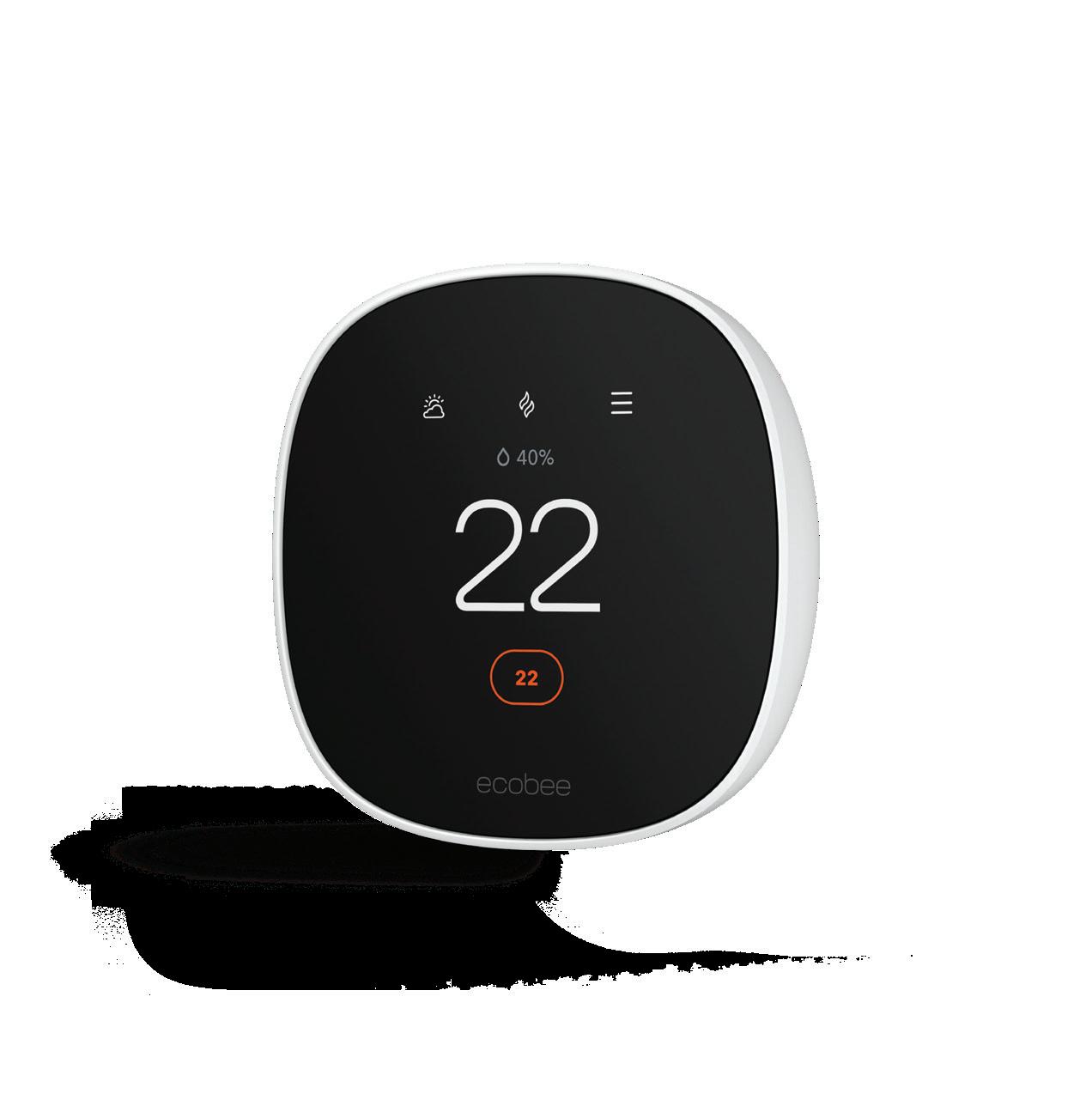
BY DOUG PICKLYK
The Canadian Hydronics Conference, a two-day tradeshow and educational event organized by the Canadian Hydronics Council (a division of the Canadian Institute of Plumbing and Heating – CIPH), returned to Western Canada with a bang, hosting a series of standing-room-only sessions and a crowded show floor September 25-26 at the River Cree Resort and Casino in the Edmonton area.
This year’s conference marked the first time in over a decade that Edmonton hosted a national hydronics event. For some it was reminiscent of the former Foothills Conferences that used to take place in Western Canada.
With over 300 people registered and 41 exhibitors, the full agenda included presentations on housing demand in Edmonton, hydronics for modular wood construction, and the prospect of hydrogen for heating in Alberta.
There were also a series of technical session for all levels of hydronics professionals covering topics like: hydronics as a career, selling hydronics, building redundancy in commercial applications, outdoor reset, air-to-water heat pumps, ECM circulators, hydraulic separation, project inspection and thermal storage.
Two well-attended panel discussions focused on the country’s track to net zero. Moderated by Jerry Leyte (Viessmann), the final panel of the conference asked: What is the Future of Hydronics in Canada?
Mike Miller (Taco Comfort Solutions) addressed the topic of air-to-water heat

pumps: “In my opinion, although an allelectric solution is where we’re trying to get to, it might not always be the best solution.” Living in Ontario, Miller has operated an air-to-water heat pump for five years, learning lessons about dehumidification along the way. He’s a proponent of using hybrid, dual-fuel, solutions for now.
The only contractor on the panel, Terence Chan, owner of Impetus Plumbing and Heating in Vancouver, emphasized the need for greater training on hybrid solutions. “As a business owner, having to get my team up to speed has been a challenge,” says Chan. “Every manufacturer’s equipment is different.”
Jeremy Young (Pro West Sales) addressed some of the common issues found when integrating air-to-water and gas boiler systems, highlighting different flow characteristics, pipe diameters and circulators, and the importance of addressing the control strategy early in the process.
“Most of the challenges I’ve had with hydronic heat pumps have not been the result of the appliances, but the integration,” says Young. “I think all of us working together to communicate best practices is one of the best ways to deal with that challenge.”
Alan Zanidean (Axiom) also focused on the planning process. “Hydronics is an artform, but with hybrid heat systems it’s very crucial that you have the entirety of the system planned and working consistently together.”
Zanidean, CHC Chair, touched on a planned initiative to improve industry collaboration and promote best practices across the hydronics industry.
Traditionally a biennial event (last held in Saskatoon, September 2022), the CHC Conference will now become an annual affair, with the next edition taking place at the Palais de congrés in Montreal, September 30 - October 1, 2025. <>

The Vitocal 100-AW air to water heat pump is designed for heating, cooling and domestic hot water. Featuring an outdoor unit, an indoor unit and a steel buffer tank (20 gal). The optional domestic indirect tanks come in three sizes (53, 66 or 79 gal), and the buffer tank can be physically mounted on top of the domestic tank to save space.


The eighth edition of the Modern Hydronics Summit delivered education and excitement. BY
HPAC STAFF
The hydronics community from the Greater Toronto Area and further afield gathered at the Paramount EventSpace on Thursday, September 12th for the eighth edition of the oneday Modern Hydronics Summit.
Started in 2013, the Modern Hydronics Summit, produced by HPAC Magazine, brings together expert speakers and product manufacturers and distributors to share the latest in technology and know-how with the mechanical contractors who design, install and service hy-
dronic systems in Canada.
The conference and tabletop trade show has been growing larger with every edition in the Toronto area, and once again the exhibit space at this year’s event was sold out. Before the presentations kicked off, and between the sessions, attendees explored the 50-plus booths in the show hall and lobby space.
For the second time in Toronto, the Summit included a special day-long series of Hydronics 101 sessions held off the main floor and hosted by NEXT

on small-scale hydronic cooling.
Supply. This year NEXT coordinated the topics and speakers, and the attendance almost doubled from the first effort in 2022.


Also, for the third time live boiler panel builds were taking place in the lobby during the event. This year’s educational panel build was coordinated by social media promoters Terence Chan of Impetus Plumbing & Heating/Impetus
Media along with Adam Gordon of Orella Group. The builds were generously sup -
ported by manufacturers and distributors, led by Taco Comfort Solutions, working together to support and lift the next generation of hydronics talent. Each of the three builds were led by experienced HVAC social media personalities (Mike Flynn, George De Jesus and Tyler Dynes) who worked along with other influencers and industry newcomers who
Three simultaneous educational panel builds were taking place in the lobby, led by social media regulars Michael Flynn (@flynnstone1), Tyler Dynes (@dyneshvac) and George DeJesus (@georgetheplumber).
signed up to participate and learn.
Like last year, the three panels will be heading to college trade programs, including Mohawk College in Hamilton and Conestoga College in Cambridge, Ont.
Continued on p18

Hello Autumn, May you bring that best feeling of stepping into a warm home, with the smell of freshly baked apple pie in the air. We can help with the warmth, but for the apple pie… the only expert you should call is your grandma!




Scan the QR code below to register and get a chance to win $500 worth of Dettson products. Visit the form for the terms and conditions.
How to participate :
1. Scan the QR Code below 2. Fill out the registration form Thats it ! You’ll be automatically entered for a chance to win.
A lucky winner will be selected at random on December 1st, 2024, and contacted via the email provided in the form.
Scan here to get a chance to win $500 !



Industry expert John Siegenthaler started the day with a presentation on adding an air-to-water heat pump to a legacy hydronic heating system. Siegenthaler addressed the different types of heat pumps on the market, their performance characteristics and how to integrate the system with boiler set ups. Among the many reasons for keeping a boiler include: a backup heat source, avoiding an electrical panel upgrade, resiliency in blackout conditions and possible load shifting. Siegenthaler concluded with sample piping diagrams and reinforced the importance of moving towards low supply temperatures. He was followed by the Controls Panel, a group discussion on integrating controls into modern hydronics systems. Panelists Mike Miller (Taco), Jay Vath (tekmar) and Curtis Bennett (HBX Controls)
“It usually makes sense to keep the existing boiler.” - Siegenthaler
addressed questions from HPAC editor Doug Picklyk. All three stressed the importance of incorporating the control strategy early in the design process, noting it’s easier to use existing control logic built into off-the-shelf products than trying to customize controls once a project has been installed.
During the lunch break one of the panel builds was moved into the main showroom. The design for this panel was a collaboration with John Siegenthaler and incorporated the piping to an air-towater heat pump. With a live feed on the


Sharing best practices and lessons learned from air-to-water heat pump system design and installation experience, panelists (l-r) Benoit Maneckjee (ThermAtlantic), Chris DesRoches (Swegon), and Roger Abdo (Hydro Solar).
overhead video screens, Siegenthaler provided a live walk-thru of the design as the team was working on the finishing touches.
The afternoon included a panel on lessons learned from existing air-to-water heat pump installations in Canada. Three panelists, Benoit Maneckjee (ThermAtlantic), Roger Abdo (Hydro Solar) and Chris DesRoches (Swegon) shared insights from their experience selling, designing and installing systems in Canada.
Then Siegenthaler returned with a presentation on small scale hydronic cooling, addressing cooling options with heat pumps, avoiding condensation, and demonstrating some system design concepts.
The main stage concluded with the announcement of the 2024 Sweet Heat hydronics installation contest, and two



O’Connor of POC Plumbing and
(centre) won a Kane HVAC/R clamp meter, presented by Steve Casalinuovo, Kane Canada (left) and Doug Picklyk (HPAC)

Winners of the Blue Jays tickets courtesy of Aqua-Tech/Lochinvar: (l-r) Ross Koirala, Aqua-Tech; Ryan Theisen, Aqua-Tech; Michael McCallum, McCallum HVAC Design; Ken Carmichael, Bray’s Fuels; and Joe Drago, Aqua-Tech.
of the three winning companies were present to be congratulated by the judges and lead sponsor EMCO.
Once again, the Modern Hydronics Summit was made possible with the support of over 50 exhibitors and key spon-
sors including: IBC and Rheem (Keynote sponsors); Resideo (registration); Roth (refreshments); Taco (bar tickets); Caleffi (dinner); Kane Canada (tool prizes); Lochinvar/Aqua-Tech (ticket giveaway); Grundfos (WiFi); Weil-McLain (show guide); and Next Supply (hydronics 101).
The date and time for the 2025 Modern
Hydronics Summit will be announced in the coming weeks. And an online video replay of John Siegenthaler’s presentations from this year will be streamed during live webinars Thursday, November 21 and Friday, November 22 with John available for questions. Visit hpacmag.com/ siggy-replays for more details. <>


Three winning projects in the fourth annual HPAC Magazine Sweet Heat Awards reveal variety and ingenuity in hydronic system designs. BY
DOUG PICKLYK

For the fourth year running, HPAC Magazine organized the annual Sweet Heat hydronics installation contest, a competition for contractors across Canada to share photos, explain the challenges they encountered and the creative solutions they used on projects completed in the past year.
This year’s competition received 26 entries, and for the first time the projects were divided into three categories: commercial, residential new build and residential retrofit.
Once again, the competition was generously sponsored by nationwide wholesaler EMCO, with the winning entry in each category receiving $2,000 vouchers at their local EMCO branch.
The final evaluations were performed by three judges: hydronics expert John Seigenthaler who brings over 40 years of industry experience to the role; Brian Morgan, a long-time industry veteran and owner of manufacturer’s representative agency The Morgan Group; and Jeff House, a specialized veteran in the
hydronics field providing sales, consulting, training, design, and hands-on jobsite instruction across Canada since 1991, currently with Hydronic Systems.
“All the entries showed excellent craftsmanship - very meticulous component assembly skills,” said Siegenthaler. “If this were a contest based solely on installation skills, pipe fitting in particular, it would be very hard to pick a winner.”
Looking forward to next year, he has a recommendation for those entering the
Continued on p22

The central element of any residential or commercial hydronic heating system. Take advantage of electricity for heating and domestic hot water production. Choose Canadian expertise and know how!
contest: “Most entries focused on the boilers (or in limited cases on the heat pump) as heat sources. Very few discussed the distribution system or heat emitters in any detail. It should not be a contest about who has the fanciest boiler room. It should be about the overall system with better descriptions of the emitters and the overall system.”
With that in mind, following are this year’s winning entries.
The winning project in the commercial category is a roughly 60,000 sq. ft. greenhouse install in Quebec City submitted by BT Energie of St. Joseph-deBeauce, Que.
Hydronics specialists with over 40years combined experience, Frédérick Baronet and Marco Toulouse started BT Energie seven years ago to focus on hydronics and using renewable energy. This project involved the conversion of a greenhouse operation from fuel oil to biomass. The Bedard Blouin Farm greenhouse grows ornamental flowers and plants as well as market garden crops and hosts a consumer market area as well.
BT Energie replaced the fuel boiler with two German-made Heizomat 500kW (1.7 million Btu/h) biomass boilers for built-in redundancy. “It’s very critical for the greenhouses to never be without heating,” notes Toulouse. BT Energie also installed two pumps on the main network for more back-up. And a 52-ton silo was installed on-site to store the wood pellets that feed the boilers.
Toulouse adds that the boiler controls (Siemens) have industrial quality connections, and he notes that Heizomat has its own online portal so the system can be monitored in real time, and alarms will notify both BT Energie and the greenhouse owners of any issues. In addition, tekmar controls were installed for cascading the boilers, and

“All the entries showed excellent craftsmanshipvery meticulous assembly skills.”
those controls also allow them to have eyes on the system, says Toulouse. Together the boilers provide hot water to satisfy a large buffer tank located in the mechanical room.
The project included a complete repiping the entire site, and Toulouse estimates they installed around 900 ft of 4-in. pipe, 600 ft. of 3-in. and different branches of 2-in., 1-1/2-in. and smaller. “I would say close to 2,000 feet of pipe has been installed.”
For heat distribution they installed 36 new fan coils, some help to inflate the greenhouse structure and some are for just heating. There are different set temperatures required throughout the greenhouses depending on the type of plants is being grown. And there is also office space and a market area that require heating in the cold weather.
The temperatures are all controlled by a greenhouse software system that monitors humidity, temperature and the more.
The boilers are also used to heat the irrigation water. “We used a heat exchanger to heat this water,” says Toulouse. A sensor in the irrigation water storage tank will trigger a recirculating pump to keep that water around 18 to 20C.
Greenhouses are unique structures, notes Toulouse, since the walls are basically only a plastic sheet you would think the boilers would be operating at full capacity all winter long, but that’s not the case.
“In fact, you can enter in the greenhouse in February when it’s -10C outside and because of the sun’s radiation you can work in a T-shirt because it’s 10C degrees inside,” he says.
“Once the sun just goes down you need energy, and yes the boiler will work at full power during the night, and as soon as the sun rises and starts to hit the greenhouses, in less than an hour you can completely stop your boiler as there is enough heat. It’s the greenhouse effect.”
The system was installed in the summer of 2023, performing through one winter so far. They kept one boiler running during the fall and early winter as only about 25% of the site is operational. Then in February, as more of greenhouse space opens the boilers become fully operational and keep running until late April or May.
Toulouse notes that because of the Transition Energetique Quebec (TEQ) incentives for fossil fuel to biomass conversion projects the payback of this system is estimated to be less than five years, with the bonus of thousands of greenhouse gas (GHG) emissions removed from the atmosphere.

Whatever your needs may be, you can trust that you're installing a product that is produced to the highest standards.


A 4,000 sq. ft. ranch-style slab on grade bungalow project on the north end of Kingston, Ont. claimed the top spot in the residential new build category in this year’s contest.
Donaldson Plumbing & Heating, located 10 minutes north of Kingston in Inverary, Ont., submitted this entry which included a lot of in-slab piping for heating and the domestic hot water (DHW) supply.
“This customer had high expectations,” says Blair Donaldson. That included radiant heat as primary heat source throughout, an air handler for cooling and shoulder season heating, and a hot water tank sized for all the high-flow fixtures in the house.
A family business, Donaldson was started by Blair’s father in 1982, and Blair grew up around the business and has been involved and working on hydronics jobs for 20 years.
For this project, the homeowner works in the construction trade and knew what he wanted. Because the early building phase was in the winter, and the owner wanted to get the heat on, he insisted on glycol in the whole heating system.
The in-floor has eight zones, including a screened-in covered porch area. Slab sensors and air sensors were installed throughout the house. Because of the high-end hardwood the slabs cannot exceed a maximum temperature or it could void the hardwood warranty.
The system uses tekmar thermostats and a couple different manifold locations with telestats (zone valves) on the manifolds. There is floor warming in the bathrooms and a towel warmer in the ensuite bathroom that runs on a timer. “He added a few things along the way,” notes Donaldson. Fortunately, the owner also wanted a nice-size mechanical room that was off his garage. “And he was the one that actually wanted the checker plate on the walls,” says Donaldson. During the judging, Siegenthaler did ask, “What is it with all

the diamond plate in Canada? Are the customers asking for the diamond plate, or is the installer doing it to enhance the system appearance with the customer picking up the cost?” Well, in this case it was the customer’s call.
The system uses a Navien NFB 175 boiler, and it has a tekmar controlled digital mixing valve with an outdoor reset to monitor the different temperatures required for the air handlers, radiant and the DHW.
The system also incorporates a low loss header for hydraulic separation. “We always try incorporate a low loss header for all our jobs,” says Donaldson. “Everything just seems to work that much better.”
For the DHW they installed an 80-gallon tank, incorporated whole house recirc and large diameter insulated piping to satisfy the high flow fixtures and large bathtub.
“The system has met all the requirements the customer wanted in their hot water and heating system as everything functioned as designed,” notes Donaldson.
The winning entry in the residential retrofit category started as a potential boiler replacement and turned into a complete system overhaul with the design and installation performed by Farr Mechanical of Stouffville, Ont.
The large home, roughly 12,000 sq. ft. complete with indoor pool, is located in Thornhill, just north of Toronto. According to Tyler Dynes, who took the lead on the installation of this project, the original design was poorly organized and required constant servicing, so instead of adding more band aids the owner agreed to revamp the entire system.
“We replaced everything: air conditioners, boilers, furnaces, water heater, and I even went through the pool system with a fine-toothed comb,” says Dynes.
Continued on p26



MECHPRESS Carbon Steel Press Fittings are compatible with Schedule 10 to 40 carbon steel pipe (including seamless steel pipe) in sizes ½” to 2”. MECHPRESS fittings suit various carbon steel systems in residential, commercial, and industrial applications.
Zinc-nickel coating for corrosion resistance
Sealing elements ideally suited for each application:
•EPDM for Mechanical and Fire Protection systems (MECHPRESS)
•HNBR for Gas and Fuel Oil applications (MECHPRESS-G)
Dual visual confirmation ensures fittings are pressed before going into service
Each fitting is marked with colour-coded dots for easy identification:
•Green for MECHPRESS (Mechanical & Fire Protection Systems) and
•Yellow for MECHPRESS-G (Gas & Fuel Oil Systems)
Fittings can be pressed with current industry carbon press tools and jaws
15-Year limited warranty

MECHPRESS
Mechanical & Fire Protection


MECHPRESS-G Gas & Fuel Oil



The mechanical room is about 1,000 sq. ft., and Dynes recommended building a 17-ft. wall in the middle of the room to attach all the controls, piping and boiler set-up in one place. “Once we had a plan in mind, it just flew together,” says Dynes.
The home has five in-floor heating zones including: a slab in the garage; a slab in the basement; second floor bathrooms with a thin slab on the floor; and a lot of staple-up in other areas. “That’s why you see five different mixing valves at the very end of the manifold,” explains Dynes. “It’s because we have different temperatures going to all those different radiant zones.”
And there are also high temperature zones which feed five hydronic furnaces as well as a heat exchanger for the pool and hot tub. The system uses a buffer tank between the two NTI boilers and zone circulators for hydraulic separation and to comfortably handle micro-zones with no fear or short cycling.
The set point for the buffer tank is 160F. “I try to keep temperatures as low as we can,” says Dynes. “I’d rather hear that the fuel bill was great, and that everything else is working great. I am always about trying to lower my boiler
temperature because the lower the temperature the more you stay in your condensing state, which is better.”
The boilers also feed an indirect tank located behind the wall for the domestic hot water (DHW). The NTI boilers with internal pumps are set up with domestic priority, so when there is a call from the indirect tank, a diverter valve in the boiler directs the flow to the DHW instead of the heating system.
Farr Mechanical also installed new air conditioning units outside the house and placed slab air conditioning coils in the furnaces so they can provide heating and cooling in those zones.
The original thermostats in the house used only two wires, making it impossible to install many modern WiFi stats in each zone without rewiring the house. But the company chose the tekmar Invita thermostats which only require two wires along with interface modules that they were able to locate in the mechanical room.
The system is also accessible via an app. “I can diagnose the system without even going there,” says Dynes. He also set up the homeowner with the same access.
One of the Sweet Heat judges, Jeff House, commented: “The install was
neat and simple. With all the exposed copper piping, insulation should have been installed, which may have been done after the installation photo.”
However, Dynes shared that no insulation was installed on this job. “The customer liked seeing the copper so much, he said, ‘I don’t want to cover it.’”
Despite taking the lead on the install, Dynes notes that it was very much a team effort. “It’s a nice team that we have here, and being able to put our heads together we can come up with some great ideas.”
This year two entries tied for the runnerup distinction in the residential new build category. Denrite Mechanical of Edmonton was selected for the installation of the heating and hot water system in a tiny 550 sq. ft. home, fitting the mechanical room into a broom closet.
And Schuller Solutions was recognized for a project on a large house in a remote area around Peterborough, Ont. Reliant on well water and propane, the home’s location necessitated an energy-efficient system with built-in backups and the ability to supply multiple
Continued on p28



temperature options.
The runner-up in the residential retrofit installations went to a high-end 5,500 sq. ft. radiant floor heating installation in Oakfield, Nova Scotia that incorporated a 10-ton air-to-water heat pump system with electric boiler for back up. The system was installed by hyronics contractor S. Robinson Mechanical of Halifax, along
with Glenmar Heating and Air Conditioning of Fall River, NS and CE Fisher Electric of Wellington, NS.
The runner-up in the commercial category went to Boss Plumbing in Saskatoon for an installation in the company’s new shop that includes a 9,600 sq. ft. warehouse and office space with infloor heating. “Design in -

YOUR TRUSTED HOME HEATING AND COOLING PRODUCTS PARTNER
Conforto Panel Radiators offer the perfect blend of radiant heat and sleek design. Trusted in European homes for over 40 years, they
are versatile enough for primary heating, supplementing radiant floors, or working with traditional systems. Virtually silent, they provide both radiant and convective heat for unmatched comfort.


confortohvac.com
contact@confortohvac.com

spiration was drawn from the principles outlined in John Siegenthaler’s Modern Hydronic Heating textbooks,” notes the company. The energy-efficient low-temp system serves not only as a heating system for the shop but also as a showpiece for customers.
Thank you to all the contractors who took the time to enter the 2024 Sweet Heat contest. These entries provide great examples of the exceptional hydronic heating projects being done year after year across Canada.
HPAC Magazine would like to encourage all hydronic system installers in Canada to keep photos of their best work and enter next year’s edition of Sweet Heat. <>
Thank you to all the contractors who entered the fourth annual Sweet Heat hydronics installation contest:
• 4R Mechanical, Wetaskiwin, Alta.;
• A. TECH Mechanical, Welland, Ont.
• Boss Plumbing, Saskatoon, Sask.
• BT Energie, St. Joseph-de-Beauce, Que.
• Canuck Mechanical, Prince George, B.C.
• Capp Mechanical, Coldwater, Ont.
• Chenier Mechanical, Finch, Ont.
• Denrite Mechanical, Edmonton, Alta.
• Donaldson Plumbing & Heating, Inverary, Ont.
• Ed Verboom Plumbing, Simcoe, Ont.
• FARR Mechanical, Stouffville, Ont.
• GTAHeat.ca, Concord, Ont.
• John Sadler Plumbing & Heating, Surrey, B.C.
• Klimatrol, Brampton, Ont.
• Paramount Plumbing, Florence, Ont.
• Pipe Right Plumbing & Heating, Brantford, Ont.
• POC Plumbing & Heating, Coldwater, Ont.
• RNJ Mechanical, Delburne, Alta
• S. Robinson Mechanical, Halifax, N.S.
• Schuller Solutions, Stouffville, Ont.
• TJL Mechanical, Fergus, Ont.
There are still viable applications for solar thermal technology. BY JOHN
These days, the term solar energy is almost always associated with photovoltaic (PV) systems that produce electricity from sunlight. Those systems range from a single small PV module used to maintain charge in a 12-volt battery, to acres upon acres of land used to create a “solar farm” that, by day, generates megawatts of power.
Few would have envisioned such a situation back in the 1970s when I got my first job with a firm that designed and manufactured solar thermal collectors.
Back then PV panels were reserved for mission critical or spacecraft applications, where the $1,000/Watt cost (in 1970s dollars) was acceptable.
Outside of that small niche, solar thermal applications were the norm, with much of the market focused on residential solar space heating.
Houses were constructed as supporting structures for massive solar collector arrays in an attempt to approach 100% solar heating. One example, from 1978, is shown in Figure 1.
Many collector arrays of that vintage were grossly oversized for swing season loads, and they required costly heat dump provisions to “survive” intense summer sunshine.
That first round of interest in solar thermal technology in North America all but died during the latter 1980s and stayed quiet through much of the 1990s and first part of the 21st century.
The solar coals were rekindled around 2008 driven by increasing concerns

SIEGENTHALER
ways interested me is what I call a “solar DHW+” system. The primary load for these systems is domestic water heating, and the “+” implies a small contribution to space heating, mostly during those swing seasons.
This approach keeps the solar array limited to minimize overheating potential in summer, and it also leverages major components of the system, such as the storage tank, for multiple functions.
over global warming and well as some energy price spikes. However, this time around much of the industry recognized that using solar collectors to offset a high percentage of conventional fuel for space heating was not a realistic goal. Domestic water heating became the preferred load to be paired with solar thermal collectors. The primary rationale being that domestic water heating was a year-round load, as such it benefited from abundant solar radiation and higher ambient temperatures for several months every year.
Another benefit was that domestic water heating operated at lower average water temperatures compared to those typically needed for space heating applications.
Although the market for solar thermal systems is a tiny fraction of what it once was, I still believe there are viable applications that could help in decarbonizing modern thermal energy systems.
One system configuration that has al -
The energy collection potential of a solar DHW + system is also better matched with the load in modern energy efficient homes.
One approach to a solar DHW+ system using a dual coil thermal storage tank, is shown in Figure 2 (next page).
The water in the tank’s shell is “system water,” not domestic water. The lower coil provides heat input from the solar collectors. Its position within the tank maximizes the average temperature difference between the outer surface of the coil and the coolest water in the tank.
The tank also provides hydraulic separation of the boiler circulator and variable speed distribution circulator.
The solar collectors are part of a closed circuit operating with an antifreeze (glycol) solution. That circuit is equipped with filling/purging valves, circulator, air separation, expansion tank, pressure relief valve, and high point air vent.
The collector circulator is operated by a differential temperature controller that continually monitors the temperature in the lower portion of the storage tank and the absorber plate in one of the solar
Continued on p30
collectors. The circulator control action could be on/off or variable speed depending on the temperature differential between the absorber plate and the tank.
The upper coil extracts heat from the water in the tank and transfers it to domestic water. The upper coil must be constructed of copper or stainless that’s compatible with domestic water.
This is a “single pass” coil. Cold domestic water enters the lower coil connection and absorbs heat as it flows upward and eventually exits the coil.
Combination isolation/flushing valves have been installed near the inlet and outlet of this coil, allowing it to be periodically isolated from the system and flushed with a mild acid solution to reduce scale build-up.
The temperature of the domestic wa -
ter leaving the upper coil depends on the temperature of the water surrounding the coil, as well as the coil’s surface area and the flow rate through it.
Slower flow rates, and thus more “dwell time” in the coil, may allow the domestic water leaving the coil to approach the temperature at the top of the tank.
The need to provide supplemental heating of the domestic water leaving the coil depends on the upper tank temperature and rate of flow through the coil.
If the coil is generously sized, remains free from scaling, and the water in the tank is maintained at least 10F above the expected DHW outlet temperature by the boiler, there is likely no need for supplemental heating. However, those perquisites are not always met - more on this later.
Given the possibility of some really productive solar days (e.g., sunny and warm) it’s crucially important to include the ASSE 1017 rated anti-scald mixing valve in the DHW assembly to protect against high temperatures entering the building’s plumbing distribution piping.
The thermal mass of the storage tank helps stabilize domestic hot water delivery. The tank also provides buffering for the zoned space heating system, which in Figure 2 consists of several panel radiators and some radiant panel circuits, all regulated by thermostatic radiator valves. A variable-speed pressure-regulated circulator operates 24/7 during heating season to match the system flow needs. A motorized mixing valve, operating
The NEW I-SERIES Plus™ line of Solo and Combi Condensing Gas Boilers offers unmatched value and performance with an expanded product line of 14 models that range from 60-199k Btu.
Now you can Rely on Rinnai for all your Residential Heating projects no matter the size or complexity.
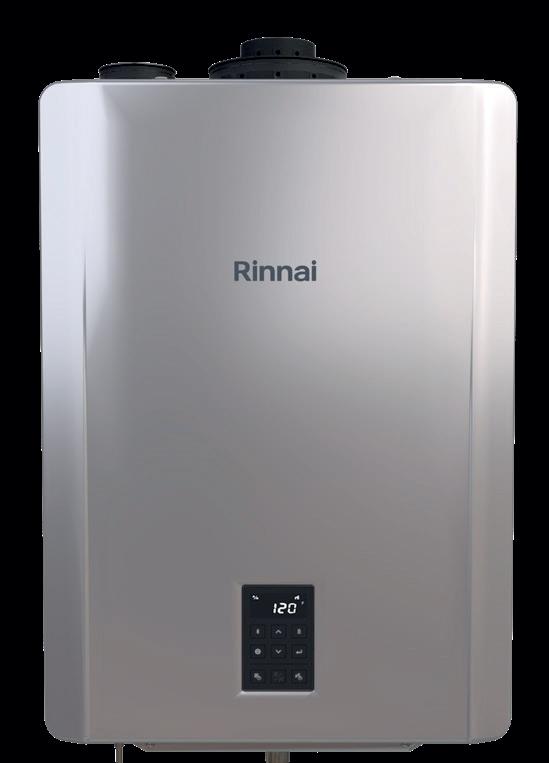




Allows you to connect your smart phone or tablet to the SENSEI® RX Series via Bluetooth®
Use the Rinnai Central™ App for quick, simplified boiler set-up and registration, significantly reducing your install time.


Rinnai’s Adaptive Gas Valve Technology lets you select your fuel type with the touch of a button on the unit controller or your smart phone. Conversion Kits not required. Smart Sense™ is only available on 60-150k BTU units
4 Built-in Zones for better comfort and savings.








on outdoor reset control, ensures an adequate but not excessive supply water temperature to the heat emitters.
Low temperature emitters that can provide design load space heating at supply temperatures at 120F are possibilities. The lower the supply temp., the greater the “solar yield” of the system.
Another variation of the “solar DHW +” system replaces the boiler with an airto-water heat pump (Figure 3).
The heat pump provides supplemental heat input when needed, but its performance is more constrained compared to the boiler. To optimize the heat pump’s performance, the water temperature in the storage tank should be as low as
possible but still able to provide the required heat output at the heat emitters.
Outdoor reset control is ideal in this situation. Based on simulations I’ve done, the seasonal COP of the heat pump improves when this method of control is used in lieu of maintaining the tank temperature based on a setpoint high enough to fully heat domestic water to a temperature of 120F or higher.
Domestic water is “preheated” as it passes through the upper tank coil. A tankless electric water heater provides the final temperature boost.
All domestic hot water passes through the anti-scald valve before entering the distribution system, and the motorized mixing valve is needed if the heat emitters could be damaged or if
Figure 3. A solar DHW+ system incorporating a split system air-to-water heat pump instead of a boiler.
unsafe surface temperatures could be created when the tank is heated by the solar thermal collector.
The “Solar DHW +” concept is a “sweet spot” for solar thermal technology coordinating well with low energy homes.
The all-electric option is well suited for those aiming for “net zero” energy status. It’s worth keeping this concept in your renewable energy portfolio. <>

John Siegenthaler, P.E., is the author of Modern Hydronic Heating (4th edition) and Heating with Renewable Energy (visit hydronicpros.com).



More reasons to consider embracing solar thermal for heating the water in our buildings. BY CURTIS BENNETT
We have all seen movies where the bad guys take the car battery, attach cables to it, and either the floor is wet, or they take wet rags or sponges and attach them to the cables and threaten the hero. I always laugh at this. I laugh because who hasn’t touched both sides of the car battery? It does not do anything. Or does it?
Have you ever stuck your tongue on a 9-volt battery? Don’t lie. I know you have. LOL.
Where am I going with this? Well, you may have guessed it, I shocked myself yet again. This time my son was there to see it and say, “Hey dad, you have another electrocution story.” We both laughed.
I have an electric motor for my small fishing boat. We were done fishing for the day after catching a few fish. I had to filet them, and my hands were still wet. I went into the house and saw that the battery had not been put back on its charger. I needed to unscrew the poles to hook the charger back up. Well, I grabbed both the positive and the negative at the same time. Normally not a big deal, BUT I had wet hands. Needless to say, there was a fairly good squeal that came out of me, and a good laugh from my son.
I have said it before, and I will say it again. Solar is my favorite hot water heating device. It just is. You take this “free” energy, and you can use it to heat water. It’s amazing.
Last year I wrote about the differ-
ences between photovoltaic and solar thermal in my article ‘Here Comes the Sun’ (HPAC, December 2023). If you haven’t read that one yet, you should. It will give you more background for what I am about to get into for this article.
In summary, the basic conclusion of that article was that solar thermal is superior to photovoltaic solutions because the conversion from heat to heat is more efficient that from heat to electrical power. Ok, knowing that, how does that help the HVAC industry? Well, that’s today’s topic.
Because I covered the concept of how heat is captured via solar in that previous article, now I’m going to discuss what we do with that heat energy.
Let’s start with the basics. We know that the heat has been transferred to a fluid from the solar panels, and of course the best way to move fluid is with a pump.
Now, since we are all hydronics’ people, we know that when we have fluid with heat in it, what we really have is usable energy.
Once we have usable energy in our fluid, next we need to transfer it to our heating device(s) (radiators, fan coils, you name it …). In this case we need a heat exchanger, this could be flat plate, coil in a tank, or really whatever option you choose. The easiest one is an indirect coil in a tank.
The hot water from the solar thermal collector then heats up the domestic hot water (DHW) to be easily used by the house or building. Free domestic

hot water, well it’s free during the day, or at least when the sun is out.
Another cool setup for solar thermal is the crazy stratified solar thermal storage tank. I am shaking my head when I say that. I say ‘crazy’ because if you have ever seen one of these— especially on the inside—they have pipes and heat exchangers everywhere.
They work on a stratification principle that you will have different temperatures at different levels in the tank, so you can use these different temperatures to heat different items with the same tank.
You might have some high temperature items like radiators, you can take the heat from the top of the tank. Maybe some DHW that uses the middle of the tank, and then in-floor radiant that would use the coolest section of the tank to heat the floors. These tanks make it easier to do more than one

thing with your heated solar water.
If you want to get into a little bit of physics, as water heats up it has less capacity to hold more heat as it’s less dense and “lighter”. Why is this important? Well, the lower the water temp we are heating with the solar the more heat it can absorb, that’s entropy.
I really hope I got that right; I always mix up enthalpy and entropy. Anyways. I don’t want to go much deeper than that, but just remember that fact.
What that means for us is we will get more out of our solar system if we are “using” the energy during the day. If we heat up a tank to its max, then use that energy we are actually not getting the most out of the system.
So, to get the most efficient system means keeping the system temperature as low as possible so it can absorb the most possible heat when the solar is generating.
“When we have fluid with heat in it, what we really have is usable energy.”
“Is this even possible?” you ask. Yes, the easiest scenario is if we are using solar for DHW. Do the laundry during the day, do the dishes during the day, use the hot water during the day. Sometimes easier said than done, but that will give you the most efficiency. Or, obviously, if there are other things you can use the DHW for during the day, then also do those. The hotter the tank, the more heat loss you will get from the tank itself, so the sooner you can use that energy, the better.
This comes into play as well for using solar thermal for home heat generation. The more efficient the envelope the less heat you need to keep the house warm. It also means you can use lower water temperature to produce the same effect.
Remember BTUs are BTU’s — I love that saying.
Just like in the DHW situation, if the heated water temperature is lower it is more efficient. Efficiency is ALWAYS a good thing.
There are some different ways to get more solar heat at different times of year.
Refraction on the solar panels or tubes plays a big part on the panel’s absorption ability.
Solar gain is at its highest when the panel (or tube) is perpendicular to the sun’s rays, at a 90-degree angle to it. This way you get no refraction.
We can use this to our advantage if we want to heat our house with solar in the winter.
Keep in mind you will still have to make other provisions for cases where you’re making too much heat, but keeping your panels at a high angle will make them more efficient in the winter than in the summer. At least in this case.
Wow, I feel like I gave you 10% of the information on 10 different topics today. So, I apologize. The distribution topic of solar thermal can actually get pretty in depth, but I hope this small overview gives you some interesting food for thought. <>

Curtis Bennett C.E.T is product development manager with HBX Control Systems in Calgary. He formed HBX Control Systems with Tom Hermann in 2002. Its control systems are designed, engineered and manufactured in Canada to accommodate a range of hydronic heating and cooling needs.

Piping Canada Post’s newest and greenest parcel sorting facility required coordination and technological efficiencies. BY BRETT
LLOYD
The new Albert Jackson Processing Centre in Scarborough, in the east end of Toronto, is a $470-million state-of-the-art parcel distribution warehouse and an expansive net-zero facility that can process more than one million packages daily, positioning it to keep pace with the country’s growing ecommerce service demand.
“The Albert Jackson Processing Centre is much more than a building – it is a generational investment in the future of our country,” said Doug Ettinger, president/CEO of Canada Post at the centre’s grand opening, September 21, 2023. “This facility will drive our network nationwide and help support the Canadian
economy for decades to come.”
The project also holds a significant place in Canadian history. It is the largest Zero Carbon Building Standard industrial project to date and it commemorates Albert Jackson, who became Canada’s first Black letter carrier in 1882. Jackson’s colleagues denied him the right to work in the role he was hired for until Toronto’s Black community rallied behind him and the federal government stepped in. Several members of the Jackson family, including one who currently works for Canada Post, attended the grand opening ceremony. The building is not only a technical achievement but represents a legacy as well.
LPI Mechanical, a full-service designbuild, HVAC and plumbing contractor, was awarded the mechanical scope for the 585,000-sq. ft. facility — roughly the size of six CFL football fields.
The company was tasked with piping the heating mechanical room, cooling mechanical room and main penthouse hallway, and installing two 3-in. perimeter heating lines on the processing floor. The facility includes 70,000 sq. ft. of office and administrative space that occupies two-storeys. The operations area, with 40-foot ceilings, occupies the remaining 515,000 sq. ft.
Interior spaces in the processing cen -
tre include a main lobby, a cafeteria, a wellness centre, and training rooms with lockers and showers.
Fitted with 155 high docks, the facility has extensive paved docking as well as parking and truck circulation areas around it. A key element of the plant is its speed of delivery. A package can arrive, be processed and be ready for dispatch in less than four minutes.
The original construction schedule for the site required LPI to complete the work it was doing in under six months, but unanticipated challenges emerged including the coronavirus pandemic causing supply chain delays along with labour shortages.
The project’s success depended on LPI’s ability to offset risk and streamline installation, which they achieved through a collaborative partnership with the virtual design and construction team at pipe joining solutions manufacturer Victaulic.
The processing facility achieved Canada Green Building Council (CaGBC) Zero Carbon Building Design certification in February 2022. Sustainability design requirements included elements like continuous skylights and windows in the processing areas, LED lighting and occupancy sensors.
Photovoltaic (PV) power generation provides a minimum of 5% of the building’s annual energy requirements, thereby rooftop solar panels are able to generate energy onsite and offset the facility’s energy consumption.
The building also features high efficiency mechanical systems and integration into the building automation system.
The mechanical system incorporates a primary variable pumping system, high-efficiency boilers, energy recovery ventilators, and a modern chiller plant to minimize operating costs, which contributed as much to the building’s net-
zero designation as the rooftop solar panels and the plant’s internal electric vehicles for transporting parcels.
LPI Mechanical partnered with the virtual design team at Victaulic to create 3D renderings of the mechanical spaces, including the penthouse boiler and chiller rooms. Throughout the BIM process, they optimized the piping layout to ensure the design met owner requirements and that on-site assembly would be as straightforward as possible to prevent sequencing issues that could impact the installation schedule.
“Spatial constraints with equipment and other disciplines, along with the large quantity of pipe required throughout the building, made this a complex system to map out,” said Chris Buldyke, director of construction at LPI Mechanical. “Frequent communication paired with both of our teams’ technical expertise allowed us to meet the proj -
Continued on p38



ect’s stringent constraints and later led to a seamless installation. It was an incredible collaborative effort.”
The design team provided LPI with final 3D drawings and isometrics that accurately reflected the space and conditions in which the pipefitters would be working.
Buldyke’s team used these resources to inform its logistics and installation strategies, positioning the crew of six pipefitters to perform their work on an aggressive timeline.
The detailed bill of materials generated from the 3D drawings and isometrics allowed LPI to submit early supply orders to mitigate risk even as the global supply chain remained volatile through-
out 2022’s post-pandemic landscape.
Faced with a fast-paced schedule, large scope and crew size restrictions due to remaining pandemic safety protocols, LPI Mechanical attained schedule certainty by leveraging grooved pipe-joining technology.
By avoiding hot works from the installation process, the LPI team also reduced health and safety risks and eliminated additional coordination steps for tasks like hot works permitting and cordoning off work areas.
“We estimated that a welded system would take approximately 20 weeks to complete. With the challenges of the

LPI Mechanical used Victaulic vibration isolation pump drops and outlet fittings to optimize the mechanical room installation and reduce material handling.
current labour market, we set out to find an alternate solution. Instead, we used a combination of Victaulic couplings, valves, headers and pump drops to install the mechanical systems in under
six weeks,” said Buldyke.
Coordinated material deliveries to the project helped maximize crane and labour efficiency. Supplies arrived in accordance with LPI’s installation sequence, ready to be lifted to the building’s rooftop and installed by crews immediately. Materials were organized and labeled according to their designated work areas, which the LPI team could quickly compare with their drawings and isometrics.
“The installation was quick and easy. We had all the materials prepared and delivered exactly on time to hoist onto the roof. Because we paid close attention to the pipe layout during the pre-planning phase, we didn’t have to worry about potential interferences during the actual installation, especially in tight spaces,” said Buldyke. “Altogether, we reduced our total site hours and maintained our project schedule. Everything went above and beyond our expectations.”
“We reduced our total site hours and maintained our project schedule. Everything went above and beyond our expectatations.”
After some pandemic-driven construction delays, Albert Jackson Processing Centre was finally able to hold its grand opening in September 2023. With its many innovative design features, it is revered as Canada Post’s largest and greenest processing facility.
The new site has doubled the organization’s processing capacity in the Greater Toronto Area – where most of the country’s parcels originate – and its impact will be felt from coast to coast. The plant is able to sort more than 60,000 packages per hour – 50% more than Canada Post’s previously largest parcel plant, the Gateway facility in Mississauga.
With ecommerce demands expected to double in Canada over the next decade, it is anticipated that this facility will not only help connect all Canadians with individual person-toperson parcel deliveries but it will also be providing a boost to the national retail economy.
As Canada Post continues to meet community and business needs with its new parcel sorting warehouse, the unique building design and its energy efficient HVAC systems make it a leading example among the efforts to demontrate improved green building standards across the country. And according to LPI, the building operators and owners will also































Continued from p39














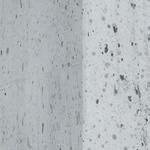





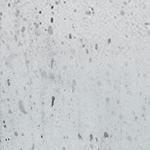


































































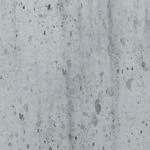








find that ease of maintenance was a key consideration throughout the overall mechanical design process.
“We designed these systems with the end-user’s experience in mind,” explained Buldyke. “The grooved pipe components can be quickly and easily removed for regular service inspections, and if the owners decide to replace the air handling units or chillers in the future, whether because of age or to expand capacity.”
As noted by Canada Post, the facility is an important piece of the organization’s transformation plan and will help the company deliver on its purpose: a stronger Canada – delivered. <>
Brett Lloyd is a Greater Toronto Area sales representative for Victaulic. brett.lloyd@victaulic.com.




ALBERT JACKSON PROCESSING FACILITY HIGHLIGHTS
• processes slightly more than half of the volume of parcels in the Greater Toronto Area
• more than 90% of all packages are processed through automated sorters.








• a package can arrive, be processed and be ready for dispatch in less than four minutes











• able to sort more than 60,000 packages per hour
• capacity to process more than one million packages a day
• contains nearly eight kilometres of conveyors
• largest industrial project in Canada with the Zero Carbon Building Standard designation
• infrastructure supports the future electrification of Canada Post’s five-ton truck fleet
• DISTRIBUTORS • WHOLESALERS
The Heating, Refrigeration and Air Conditioning Institute of Canada (HRAI) held its 2024 Annual Conference in Vancouver from September 22 thru 24. This year’s theme was “The One Thing,” and the conference successfully carried that concept throughout with every speaker ending their talk with ‘The One Thing’ to take away from their presentation.
This year’s conference agenda consisted of a series of panels covering a range of categories including the energy grid, HVAC in uncommon places, industry consolidation, workforce development, and the refrigerant transition.
This final topic brought some clarity to what is happening with refrigerant phase downs both in Canada and the U.S.
Moderated by Pushpinder Rana (Mitsubishi Electric), the panel included Samantha Slater (AHRI), Martin Rego (Rheem), Michel Gauvin (Environment and Climate Change Canada), and Perry Chao (HRAI).
Rana, chair of CSA B52 mechanical refrigeration code committee, shared some history on the journey towards lower global warming potential (GWP) refrigerants.
The newest evolution in Canada is the introduction of ASHRAE classification A2L refrigerants (included in CSA B52). These mildly flammable refrigerants meet the GWP requirements of government phase down obligations—specifically the U.S. mandate for new residential air conditioning and heat pump units beginning January 1, 2025.
No date has been set in Canada, but Rana is not concerned. “As a cold climate country, if we can handle natural gas or propane inside our homes, A2Ls will be a piece of cake.” He assured the crowd there should be no worries of a “Kaboom” incident.
The two ‘One Things’ from Rana in -

cluded: become familiar the CSA B52 code, and take A2L training.
For her one thing, Slater from AHRI believes it is essential for Canada to align its regulations with the U.S. as soon as possible. Rego from Rheem echoed Slater’s statement, noting the misalignment creates confusion and ambiguity in the market.
Michel Gauvin of the ECCC noted that Canada’s current regulations came into force in 2017 and the review timeline is every 10 years, but because of changes in the U.S. and HVAC industry demand the review has started four years earlier than scheduled.
During a public consultation period this summer the government received over 90 submissions, a high number according to Gauvin, and he acknowledged there was support for an alignment with the U.S. product rules.
He assured the crowd that no new regulation will be forthcoming by January 1, 2025, and it was also made clear that as of January 1, 2025, appliances with
R410A as well those with new A2L refrigerants (R32 and R454B) can be legally sold in the country. The complicating factor could be the building codes in each province.
HRAI director of regulatory affairs, Perry Chao, provided an update of which provinces have adopted CSA B52. B.C., P.E.I., Manitoba and Newfoundland and Labrador are ready for adoption. Ontario, Nova Scotia, New Brunswick and Saskatchewan are almost ready, says Chao. And finally, Quebec and Alberta are on the path.
The new national Chair of the HRAI for 2024-25 is Chris Hann, Wolseley’s director of HVAC/R in Ontario. Hann becomes the 56th Chair of the association, taking the gavel from Tara Smith, owner of Mr. Furnace in Winnipeg.
The association also handed out awards recognizing volunteers and industry veterans.
President’s Recognition Awards were presented to the co-chairs of HRAI’s Skills Competition committee: Brad Mavin, retired from Conestoga Mechanical, and Dick Thomas, retired vice president from AtlasCare.
Recognizing outstanding HRAI Chapter leadership, the Gearld Inch Award went to Andy Gould, of Reliance Home Comfort, long-time chair of the BrantHaldimand-Norfolk Chapter.
The Merit Award, recognizing outstanding contributions to the industry was presented to Bill Davis (formerly with Ecco Supply), who served as national Chair of HRAI 2022-23.
And the Craig McCarty Memorial Award and the Life Member Award were both given to Robert Flipse, recently retired from Ainsworth. Flipse served as Chair of the national board 2020-21.

For the second year in a row, CB Supplies receives the Jacques Deschênes Supplier of the Year award: (l-r) Martin Deschênes (Groupe Deschênes), Eric Finlay (Andrew Sheret), Warren Lowe (CB Supplies) and Rob Dewar (AD Canada)
During the recent AD Plumbing & Heating Supplier of the Year Banquet in Toronto, there was a repeat winner for the first time as CB Supplies was presented with the 2024 Jacques Deschênes Supplier of the Year award. BMI Canada received the 2024 Brian Findlay Supplier of the Year award, while Great Lakes Copper was recognized as the 2024 Most Improved Supplier of the Year. adhq.com
Barclay Sales has added Trevor Hart as technical sales representative in Northern Alberta. After two decades in the plumbing industry, both contracting and on the sales side, Hart brings technical and business expertise to the Barclay team.
Granby Industries has named Ron Vanhevel as Ontario account manager. With over 35 years in the HVAC industry, Vanhevel has previous experience with Condair, Rheem, and Reliance Home Comfort. He will cover the entire province except the Ottawa and Thunder Bay areas.


Congratulations to the group of 10 Next Plumbing and Hydronics Supply athletes who completed Ironman Canada in Penticton BC on Sunday August 25th: (l-r) Jake Storfer, Michael Storfer, Hardeep Chahal, Carolina Lorenz, Randy Walton, Scott Boucher, Jimmy Thuan, Ali Azari Boushehri, Jerrie Keith Manalang, and Johnson Phan.
The Canadian Institute of Plumbing and Heating (CIPH) presented the Joseph K. Seidner award to Tom Gervais, the current director of specification and product development with Bradford White.
The Seidner award recognizes the outstanding volunteer commitments of members from across the industry toward the development of plumbing codes and standards.
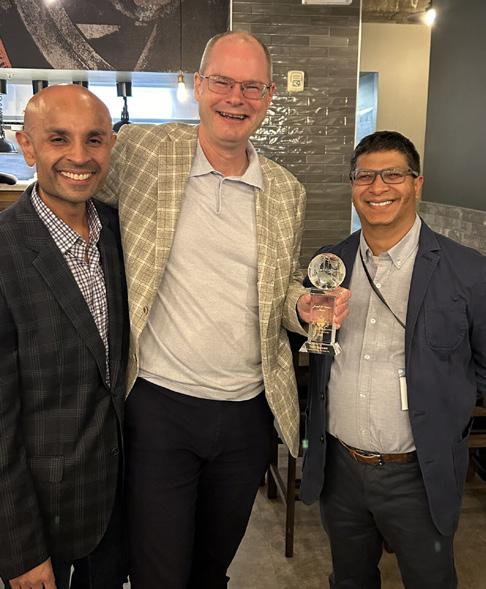
Congratulations: (l-r) Satinder Chera (CIPH), Tom Gervais (Bradford White), and Kevin Wong (Uponor).
Gervais serves as the new chair of the CIPH Plumbing and Mechanical Advisory Council (PMAC). ciph.com

Mitsubishi Electric Sales Canada has entered into a cross-promotional partnership with Efficiency Capital, an energy-as-aservice company, to make low-carbon building solutions more accessible to building owners and operators across Canada.

RenewAire has named Bojana Prorok as regional sales director for Canada. A 15-year ventilation industry veteran, Prorok is responsible for the company’s ERV and DOAS product sales through manufacturer’s representatives, national distributors and engineered system specialists across the country.
Aimed at multi-unit residential, industrial, commercial and institutional buildings across the country, the partnership combines Efficiency Capital’s project investment and delivery model with Mitsubishi’s heat pumps and related technologies. Efficiency Capital partners with building owners to deliver retrofit solutions with the costs of installing the technologies recouped through the operational savings. mitsubishielectric.ca
AD empowers independent distributors with:
• Dedicated in-market Canadian presence
• Robust financial reporting
• Multi-industry reach
• 100% member ownership and governance
• Growth programs: Networking, Sales, Leadership Education & Marketing
• Canadian warehouse & training centre

Plumbing • HVAC • Decorative Brands • Faucets • Fittings • Fixtures • Gauges • Pipe • Plastics • Pumps • Sinks • Tubing • Valves • Water Heaters • Water Product • Building Supplies • Gypsum • Insulation • Steel • Roofing • Electrical • Industrial
• Safety • Bearings & Power Transmission • Motors • Power Tools • PVF


Once again Next Supply was a major participant in the annual Road Hockey to Conquer Cancer event, the world’s largest road hockey fundraiser that took place this year at the Vaughan Metropolitan Centre on September 28th.
Next raised over $530K this year, with four Next teams eligible for the celebrity draft, enlisting Wendel Clark, Lou Franceschetti, Julia Gosling (PWHL) and Nicole Servinis onto Next teams.
This year the event raised $3.17 mil -
The HVAC industry is making a momentous transition to alternative refrigerants to meet Global Warming Potential Requirements. Manufacturers will need to meet the latest safety requirements to UL 60335-2-40 for certification. Contact our experts today to learn more.
+1 800 WORLDLAB (967 5352) icenter@intertek.com Intertek.com/HVACR FOR MORE INFORMATION
lion in total for cancer research at The Princess Margaret Hospital. roadhockeytoconquercancer.ca
ASTM International, a global standards organization and publisher of technical standards, has released the ASTM B1029: Standard Practice for PressConnect Joints with Seamless Copper and Copper Alloy Tube and Press Fittings. The document was developed alongside Viega, who participated in a consensus process documenting the best practices for creating press-connect joints.
This new standard aims to support the adoption of press-connect technology by aligning practices industry-wide and providing engineers and installers with a clear framework. viega.us
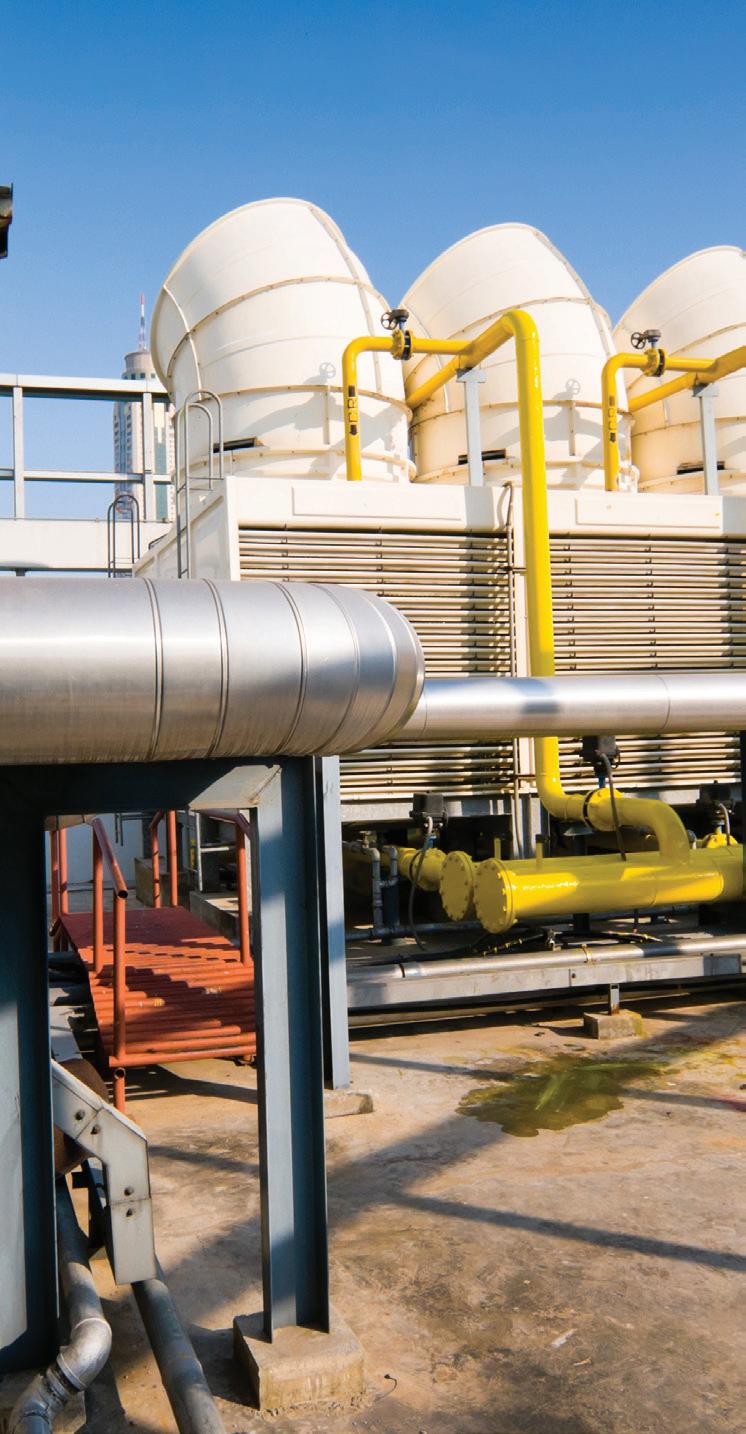
>> CB Supplies has begun construction on a new warehouse in Calgary located at 6922 107th Ave. SE in the Point Trotter Industrial Park, expected to be completed by Q1 of 2025. cbsupplies.ca
>> Aquatherm North America is partnering with Equipco as its sales representative across Canada, and Calgary-based Cascade Flow Control Solutions is now its master distributor nationwide. aquatherm.com cascadeflow.ca equipcoltd.com
>> Following recent expansions into Barrie and Hamilton, NEXT Plumbing and Hydronics Supply has added a new Rexdale location in the GTA at 50 Fasken Drive, off Highway 427 by the Pearson Airport. nextsupply.ca
>> O’Dell HVAC Group is the official GTA rep for Neptronic, a Montrealbased manufacturer of humidifiers, controls, electric heaters and actuated valves. The partnership expands Neptronic’s distribution network across nearly all of Ontario neptronic.com odellhvac.com
Innovair Solutions, the Quebec-based manufacturer and distributor of electric heating and HVAC solutions, is expanding its reach in the U.S. market with the acquisition of Warmzone, an electric radiant-heating systems specialist from Salt Lake City, Utah.
Warmzone operations include floor heating, snow melting, roof de-icing and will remain in the Salt Lake City area at its 22,000 sq. ft. facility.
This marks Innovair Solutions’ third U.S. location, complementing its existing facilities in Miami and Chicago. innovairsolutions.com

In 2024 Watts is recognizing its 150th anniversary and on August 5 the company held a ceremony featuring employees and local community partners at its global headquarters in North Andover, MA.
The headquarters’ Learning Center also hosted a dedication ceremony acknowledging former CEO Tim Horne, the building will be renamed the Horne Learning Centre. watts.com

Noble’s Fall Tradeshow took place on Thursday, September 19th at the Universal Event Space in Vaughan featuring over 85 exhibitors and five seminars. Front and centre were product demos and competitions hosted by Gary McCreadie (HVAC Know It All) and members of the Eh Team. Attendees could also preregister for Noble’s e-commerce online ordering coming this Fall. noble.ca
Winters Instruments has acquired Edmonton’s CPW Valve & Instrument, a precision pressure instruments and accessories manufacturer. Both companies will continue to operate independently, with CPW’s “Made in Canada” products continuing to be promoted and sold under the CPW brand. winters.com cpwvalve.com

Bartle & Gibson has been ringing in its 80th year with a celebratory tour of its many Western Canadian locations. The Edmonton-based wholesalers is hosting 30 customer appreciation events at various locations in all its serviced provinces including vendor displays and bar-b-ques. bartlegibson.com
RectorSeal has acquired PSP Products, a Virginia-based supplier of surge protection and load management electrical solutions. The two companies have worked together in recent years and now this strategic acquisition broadens RectorSeal’s existing surge protection product line. rectorseal.com
With completion of its field trials and laboratory testing, Carrier has achieved the Department of Energy’s (DOE) Cold Climate Heat Pump Challenge for residential applications.
First announced in May 2021, the Challenge — launched in partnership with Natural Resources Canada (NRCan) and the U.S. Environmental Protection Agency (EPA) — enlisted manufacturers of residential, centrally ducted, electric-only heat pumps, and the Challenge had two segments: one for a cold climate heat pump (CCHP) optimized for 5F (-15C) operation and the another for a CCHP optimized for -15F (-26C) operation.
The first six industry partners announced in Fall 2021 included: Carrier, Daikin, Johnson Controls, Lennox, Mitsubishi Electric and Trane. In February 2022, Midea, Rheem and LG joined the Challenge. And subsequently Bosch also joined the Challenge.
The first new Carrier DOE-challenge-designated cold climate heat pumps are slated for production in September at the company’s Collierville, TN factory.
Units include Bluetooth modules for digital monitoring and servicing through Carrier’s Connected Portal for dealers, and the units will use R-454B (A2L) refrigerant. carrier.com
Continued on p46

Rheem has announced its intent to acquire Nortek Global HVAC (NGH), a Missouri-based manufacturer of air conditioning and ventilation products with brands including Broan, Frigidaire and Maytag.

Nortek Global HVAC is currently owned by Chicago-based Madison Industries and falls under its Madison Air subsidiary, which also includes brands like Reznor, Big Ass Fans, UV Resources and more.
Madison acquired Nortek Air and its portfolio of companies from U.K.-based Melrose Industries in 2021.
Upon the close of the acquisition NGH will join Rheem’s Global Air division. rheem.ca
Aliaxis SA, parent company of IPEX, is set to acquire Johnson Controls’ CPVC pipe and fittings business for residential and light commercial sprinkler systems. Located in Huntsville, Alabama, the acquisition further expands Aliaxis’ presence in the Southern U.S. The acquired assets will be integrated into the IPEX brand. ipexna.com


MITS Air Conditioning held its annual customer appreciation BBQ on Thursday, September 19 at its Mississauga head office. This year featured a meet-and-greet with Leaf legend Wendel Clark. The event included technical training, prizes and the introduction of the new M-Thermal split airto-water heat pump. mitsair.com
HPG Sales, also known as Hydronic Parts Group, is celebrating the company’s 25th anniversary in 2024. Starting with a small warehouse in Stoney Creek, Ont. in 1999, Doug Mader and his son Andrew set up the specialty distribution business providing parts, boiler design, sales and service. Today the company has three warehouse locations in Ontario and remains a hands-on family-owned affair, and is also the leading RBI boiler and parts distributor in North America. hydronicpartsgroup.com
If you missed John’s Modern Hydronics Summit presentations don’t despair.
Replays, in full video and audio, will be aired soon. You’ll also be able to chat with Siggy in real-time.


Nov 21 at 1 pm ET:
Retrofitting air-to-water heat pumps into existing hydronic systems
Nov 22 at 1 pm ET:
Its time to consider the advantages of Small Scale Hydronic Cooling
These sessions are generously sponsored by Rheem Canada Register at hpacmag.com/siggy-replays

NTI hosted a group of contractors and friends from the GTA at a Blue Jays game in July. Great turn out for a mid-day ball game. Unfortunately the Jays lost 13-0 to Tampa.
EBTRON received two patents for its velocity-weighted temperature measurement technology. Its bead-in-glass thermistor and its ruggedized relative humidity sensor which measures velocity, temperature, relative humidity, enthalpy and dew point for controls across VAV, Economizer and DOAS systems.
The technology is now available on all models of EBTRON’s measurement device for ducts and plenums, the GTx116ePC/H. ebtron.com



Never mix your sales strategy. Know your brand and price accordingly. BY MATTHEW BIRCH
Joe Parker, the owner of Parker Plumbing, was a skilled tradesman with a reputation for excellence. For years, Joe had built his business on the promise of delivering high-quality plumbing services to homeowners across his small town. He prided himself on never cutting corners, using the best materials, and always being there for his clients when they needed him most.
However, despite his commitment to quality, Joe’s business was struggling. He was constantly facing cash flow issues, making it difficult to pay his suppliers on time or invest in new equipment. His crew was small and overworked, and the high standards Joe set for his services were becoming harder to maintain.
One afternoon, while grabbing coffee at a local café, Joe ran into an old friend, Mike, who had moved away years ago to start his own HVAC business in the city. Mike’s business had flourished, and he was now running one of the most successful premium HVAC service companies in the region. Over their coffee, Joe shared his frustrations with Mike, who listened intently.
“Joe, I’ve been there,” said Mike. “When I first started out, I tried to be the low-cost option, thinking that would bring in more clients. And it did, but it also brought a lot of headaches.
“The clients expected the world for pennies, and I just couldn’t keep up. It wasn’t until I realized that if I wanted to deliver premium service, I had to charge
premium prices, that things started to turn around.”
Mike explained that when he raised his prices he lost some clients, but the ones who stayed valued his service more and were willing to pay for the peace of mind that came with it. In fact, several of his clients even expressed that they welcomed higher prices as it gave them confidence that he would be there for them next time, and that if ever required he’d be capable of honouring the warranty he offers on his work. His business grew steadily, and soon, he was able to expand, hire more skilled technicians, and invest in topnotch tools and technology.
Joe left the café with a lot to think about. He realized that if he wanted to
continue delivering the high-quality service he was known for, something had to change.
Joe’s story is all too familiar in the trades industries. Many business owners find themselves caught in a trap, offering premium services at ‘fair’ or even low prices, only to face financial strain. While there are indeed many sales strategies that a business can employ, the key to success is ensuring alignment within the sales strategy and the businesses operations.
The reality is simple: if you’re offering premium services, you need to have a premium pricing strategy. Here are three examples that illustrate this principle:
The Premium Brand: Consider the case of Mercedes-Benz, a brand synonymous with luxury, quality, and performance. Customers pay a premium for a Mercedes because they know they’re getting top-tier engineering, high-end materials, and a driving experience that’s second to none. Mercedes doesn’t compete on price; it competes on value. And their clients are more than willing to pay for it because they understand the long-term benefits of owning a premium vehicle.
The Affordable Brand: Take Tim Hortons, a staple in the Canadian restaurant landscape. Tim’s has built its brand on providing everyday Canadians with affordable coffee, donuts, and light meals. The brand focuses on value by offering simple, consistent products that cater to a wide audience at reasonable prices. They achieve this by streamlining their menu, maintaining efficient operations, and sourcing ingredients at scale. While Tim Hortons doesn’t offer gourmet coffee or artisanal pastries, customers appreciate the familiarity and affordability of their offerings, making it a go-to choice for quick, budgetfriendly meals across the country.
The High-Volume, Low-Cost Brand:
Then there’s Walmart, the retail behemoth that dominates with its “Everyday Low Prices” strategy. Walmart’s business model thrives on scale and efficiency, enabling them to offer products at prices that few competitors can match. They achieve this by leveraging their massive buying power, streamlined logistics, and a relentless focus on cost control. Customers know they’re not getting the highest quality, but they’re getting value that’s unbeatable for the price.
“Shift your focus to attract clients who value quality over price.“
When a business attempts to deliver premium services without a matching pricing strategy, it risks financial instability. You may attract customers initially with lower prices, but over time, the demands of delivering high-quality service will outpace the revenue generated. This can lead to cash flow problems, inability to invest in better tools or staff, and ultimately, a decline in service quality.
Customers who expect premium service at a bargain price may become dissatisfied when the quality they expect isn’t sustainable at the rates you’re charging. Worse, this approach can harm your brand’s reputation, making it difficult to command higher prices in the future.
Practical Tips: If you find your business stuck in a cycle of delivering highquality service at low prices, here are four tips to help you realign your strategy:
1. Reassess Your Pricing Model: Take a close look at your costs, your value proposition, and your competition. Don’t be afraid to raise your prices to reflect the quality you deliver. Start
with small increments if necessary and communicate the value behind these changes to your customers.
2. Focus on Differentiation: Identify what makes your service unique. Whether it’s your expertise, the quality of your materials, or your customer service, highlight these factors in your marketing. Make it clear to your clients why your premium pricing is justified.
3. Target the Right Customers: Shift your focus to attract clients who value quality over price. These are the customers who are willing to pay for the peace of mind that comes with knowing they’ve hired the best.
4. Diligently Review Your P&L Statement: A 12-month rolling profit and loss statement should be your best friend. This report won’t just help you understand the profit margins you earned last month, but more importantly, how does that compare within your recent history helping you ensure the prices you’re charging are keeping up with the cost of operating your business.
Delivering premium services demands premium pricing. It’s a lesson that Joe, and many other business owners like him, must learn if they want to build a sustainable, successful, business. By aligning your pricing with the quality of service you offer, you not only ensure the financial health of your business but also enhance your reputation and build a loyal customer base that values what you bring to the table. <>

Matthew Birch is the founder of Legacy Profit Solutions, dedicated to helping business owners in the plumbing/HVAC industry secure their “Forever Bookkeeper.” Understanding unique industry needs, the Legacy network connects businesses with professional bookkeeping firms. Matthew@LegacyProfit.ca 587-879-7822.
Appreciating the often underappreciated but indispensable role of the humans on the other end of the line. BY
GERRY WAGNER
Ihave a question. Who among the following list do you think are the most under-rated, least appreciated, yet critically important people/positions in the HVAC/R distribution chain?
• manufacturer production line assemblers
• manufacturer engineers
• manufacturer and distributor salespeople
• manufacturer and distributor technical support people
• independent HVAC contractor owners
• independent HVAC installers/technicians
Look, you might not agree with me and that’s fine, but I have been on all sides of the HVAC trade/industry, and for my money the unsung heroes are the manufacturer and distributor technical support people.
I believe to understand why technical support is consistently under-rated you need to scratch below the surface and look at the human psychology involved. “Psychology?” you ask? Yeah, you read right … psychology.
Let’s be honest, reaching out to someone else for help is hard for most of us. It requires the act of surrendering, and that generally isn’t easy. Surrendering starts with a tough admission: “I can’t fix this,” or “I don’t understand this,” or even worse, “I have no idea what I’m doing.”
All of these are hard for most humans to admit — especially those of us who consider ourselves seasoned, experienced and educated HVAC professionals.
The fact of the matter is, we live in a time where HVAC technology is advancing very quickly and it’s hard for anyone, no matter how seasoned and experienced, to keep up on all that’s happening.
OK, let me just get this out of the way right now, a fair amount of us once we surrender are not happy about it. I’m sympathetic to this, truly I am. I, like most men (sorry ladies, I can only speak to the male psyche because I’m a guy), are not happy surrendering and will often take it out on the person we have reached out too for assistance.
The call we make to a company’s technical support number is not to talk about who won the football game or to discuss

the latest cool car, we are calling because something isn’t working or isn’t working as it should so there is a problem—often a really bad problem.
Bottom-line? We are unhappy because we are in a spot where we probably have an unhappy homeowner right over our shoulder asking “Why can’t you fix this? What’s the problem? When are you going to be done?”
Come on, let’s be honest, we have all been in this exact scenario at one time or another, and everything I just described is not conducive to us being pleasant with the person on the other end of the line.
I have talked to many technical support professionals in our trade and industry over the years, and a common statement they hear when someone who is unhappy with their attempt to resolve a problem is: “I’ve been doing it this way for 30 years and never had a problem.”
This reminds me of an old friend and brilliant trainer in the hydronic world, John Barba of Taco Comfort Solutions, who replies to that statement with, “Define problem.”
Just because something is working (i.e. blowing cold or hot), that doesn’t mean it’s working to optimum efficiency and capability, and who knows for how long it will continue to work.
Whenever someone throws the old, “I’ve been doing it this way for years,” statement at me, it makes me wonder, then why are you bothering me with this? If you are so smart and experienced, why are you calling for my help?
Look, I know that sounds very unsympathetic on my part, and that is not how I am.
“Put me in front of equipment that has an issue and I can help; tell me about it over the phone and I’m not effective.”
I have been that guy, and I know first-hand that those statements come out of a sense of frustration, and in most cases are not said out of malice or any “I’m smarter than you” attitude.
Let me continue to make this personal. As a trainer for manufacturers and master distributors over that last two decades, I am often the “face” of the product. I’m the nice, funny, hippie guy who taught you about the product in a four-hour in-person training event. So I am often the first person that people will reach out to for help, even after I told them not to.
That’s right, I don’t want installers and technicians calling me when they have a problem, and I tell them that in every training event I conduct. And this is why: I cannot stop a training event to pick up a phone call when someone needs my assistance. And when I’m not in a training event, I’m traveling and/or preparing for one, and again, I cannot answer the phone.
But there is another reason I don’t take those calls.
Truth be told, it’s not a talent I possess.
To be able to diagnose a problem over the phone, no matter how much information is provided by the infield technician, is just that, a talent.
I’m a licensed Master HVAC/R contractor with 40-plus years of experience. Put me in front of equipment with an issue, and I can help; describe it over the phone and I’m not effective.
Are you beginning to understand why I think the technical support people are the most under-rated, least appreciated, yet critically important position in the distribution chain?
Next time you call a technical support number for assistance (and you will), try to remember the person you have reached out to is a human being who wants to help you. That person will try to do so in a thorough yet quick and efficient manner, but they also need some basic information (generally model, serial number and place of purchase) in order to assist.
And then when you, together with their assistance, have resolved the issue, a simple “Thank you,” goes a long way. <>

Gerry Wagner is the vice president of business development for Bathica in Quebec. He has 43 years in the HVAC/R industry working in manufacturing, contracting and training. gerrywagner@bathica.com.
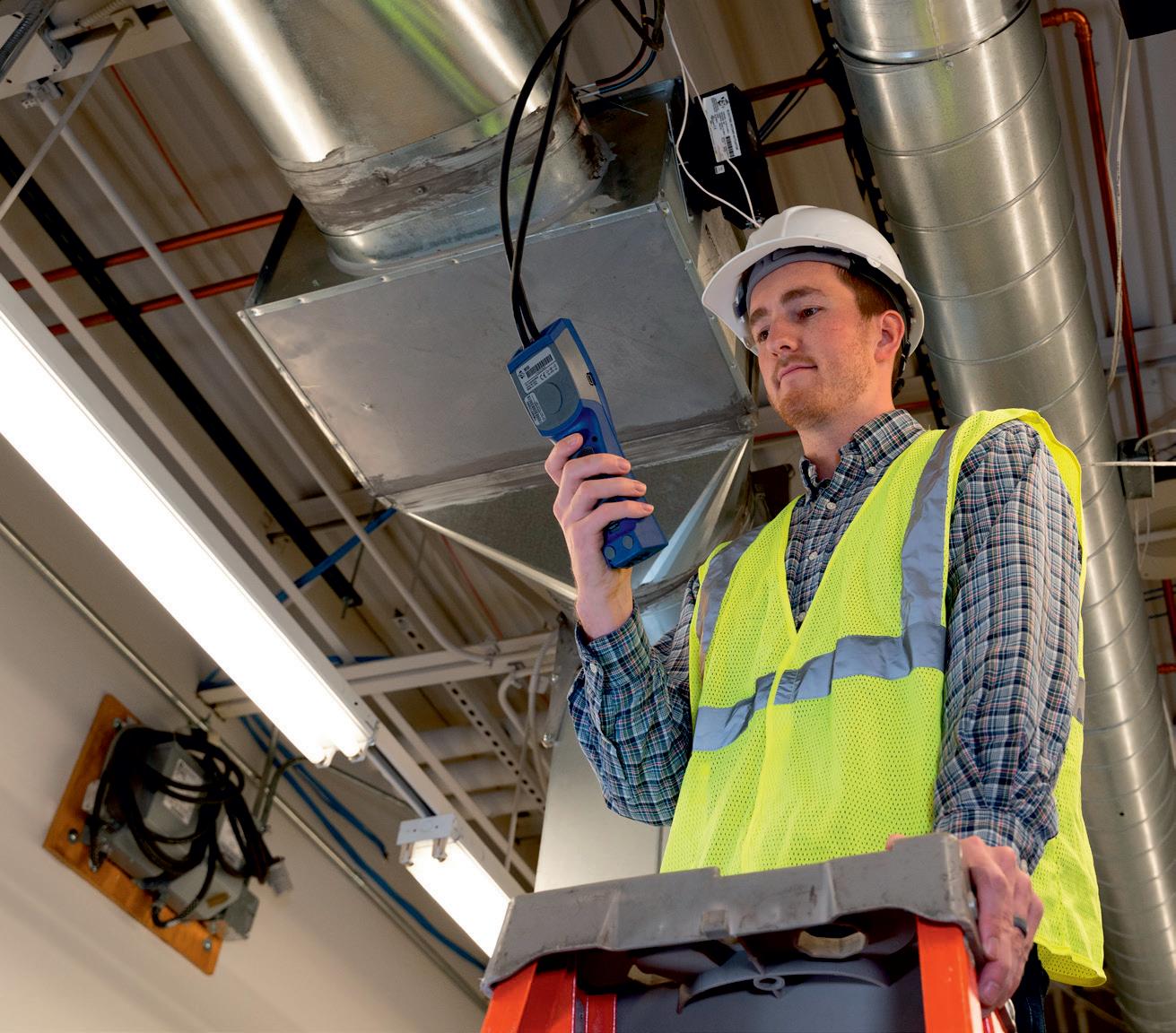



Nova Scotia-based Comeau Refrigeration is leading by example and actively trying to become a net zero operation.
BY DAN VASTYAN
Comeau Refrigeration became one of earliest adopters of minisplit heat pumps in Nova Scotia, and that decision has since helped shape the overall trajectory of the firm.
Today, the HVAC contractor is poised to become Zero Carbon Building (ZCB) Performance certified by the Canada Green Building Council and has joined the Federal government’s Net Zero Challenge.
“I didn’t begin installing mini-splits because I felt they could help reduce climate change,” says Dale Comeau, the founder and owner/operator of Comeau Refrigeration in Bridgetown, Nova Scotia. “I began installing them in 2008 simply because the technology worked. Our maritime climate was great for even the early heat pump models available at the time. We witnessed the energy savings and realized how heat pumps would play a critical role in the future of HVAC.”
Over the years, Comeau began incorporating other green technologies within his business and his personal life.
“We doubled down on heat pumps, becoming a Fujitsu Elite dealer soon after the program was introduced,” he explains. “We committed to that brand and never waivered. Meanwhile, we began to conduct our business in a more environmentally conscious manner.”
Technicians at Comeau Refrigeration are exceedingly careful when handling refrigerant. They have a fleet-wide noidling policy, and they carefully recycle old heating and cooling equipment, breaking it apart and sorting the material before taking it to a recycling facility.

They’ve also added two electric vehicles to the fleet; a Ford e-Transit van and a Ford Lightning pickup truck.
“I like the EVs more than I thought I would,” says Comeau. “They cost roughly 70% less to operate than the diesel and gas vehicles in our fleet. They’re quiet and they have electrical outlets. It’s like having a generator on the jobsite.”
The company has even taken what some would consider “extreme” measures to offset its own carbon footprint.
For example, Comeau Refrigeration purchased 30-acres of forested land just a 10-minute drive from Bridgetown. This land – which otherwise could have been clearcut – will sequester carbon dioxide and offset the company’s emissions.
Early calculations on a sample plot indicate this Acadian Forest sequesters 59 tonnes of carbon dioxide and 16 tonnes of carbon annually.
Comeau’s interest in operating a car-
bon-neutral firm began years ago, but nothing official came of it until last year.
Comeau’s partner, Kris Humphreys, is a faculty member at the School of Environment and Technology at the Nova Scotia Community College. As part of the curriculum, students conduct advanced studies on building performance and energy use, HVAC, emissions, nature-based solutions and renewable energy.
“Kris asked me if I’d host one of her students for his senior project,” says Comeau. “The student, Jake Doiron, had spent two years studying energy sustainability. We were already moving toward net-zero emissions, so it was a no-brainer.”
Doiron’s project “Pathway to NetZero,” mapped the company’s Scope 1






and 2 emissions, and then it detailed a plan to offset those emissions with nature-based solutions, electrification of the vehicle fleet and renewable energy integration.
Scope 1 emissions are direct greenhouse gas (GHG) emissions that occur from sources that are controlled or owned by Comeau Refrigeration, like heating and cooling their building and emissions associated with vehicles. It was helpful that Comeau Refrigeration operates two EVs and the building uses no fossil fuels.
In Comeau’s case, Scope 2 emissions are indirect GHG emissions associated with the purchase of electricity. Even though there are no onsite emissions for heating or cooling their building, the local utility, Nova Scotia Power, uses some fossil fuels to generate the electricity provided to its customers.
“Jake’s work is meticulous,” says Humphreys. “He invested over 100 hours in this project. At the end of the study, we made recommendations on how Comeau Refrigeration could improve and submitted the data and findings.”
“We found that Comeau Refrigeration is mindful of their environmental impact,”
says Doiron. “They’re currently working to reduce their footprint and increase building performance. The potential to add a solar photovoltaic array and increase the green space at the shop for additional carbon offset are the next steps that Comeau is already working on and planning for. Overall, the changes they’ve already implemented are exemplary and poise Comeau Refrigeration as an industry leader.”
From Doiron’s project, Comeau decided to pursue the Zero Carbon Building (ZCB) Performance standard with the Canadian Green Building Council.
Will Marshall, an environmental engineer and co-founder of LMMW Group, is the sustainability consultant working on the project. Comeau’s goal is to achieve a net zero-emissions operation.
“We’ll continue mapping carbon sequestration and storage in the forest to increase the accuracy of the calculations over the entire 30 acres. Mapping 1/100th of an acre to collect the physical data of the small sample took over four hours. It’s a huge undertaking,” says Humphreys.
“Offsetting carbon through forested land is uncommon on a small scale, and certification of credits is costly,” she adds. “We use industry-standard met-

In addition to a 30-acre plot of forest nearby, Comeau is maximizing the green space around the shop.
rics to calculate the rates, but there will be no certification of those credits in the near future. Additional certified credits to offset the company’s emissions will be purchased from the ZCBcertified list of credits. As far as we know, no other HVAC company in Atlantic Canada is doing this. The company is at the forefront of achieving netzero emissions before 2050.”
In July, Comeau Refrigeration hosted a small event to present the findings of Doiron’s project. Representatives from Efficiency Nova Scotia and employees of Master Group’s Dartmouth branch, where Comeau sources his split systems and VRF equipment, were in attendance.
When a company wishes to pursue NetZero certification, the whole operation and all energy used is taken into consideration. HVAC companies in particular have unique headwinds to overcome.
“We’re in the business of mini-split and VRF heat pumps, which have a smaller carbon footprint than fossil fuel appliances, but we certainly don’t get a free pass simply because of the high-efficiency products we install,” says Comeau.
“Jake calculated how much refrigerant we lost last year,” he notes. “Each time we connect gauges or use our refrigerant reclaimer, some gas is lost to the atmosphere despite best practices. This may seem insignificant, but the global warming potential of R410a is high. It adds up over the year.”
“When the industry switches from R-410a to an A2L refrigerant, businesses like mine will require less carbon offset than we do now,” explains Comeau. “With a global warming potential (GWP) of 2088, losing five pounds of R-410a is equivalent to driving our gaspowered service van 14,181 km. The GWP of R-32, for example, is 655, roughly 70% less than R-410a.”
Pursuing Zero Carbon Building Performance certification and joining the Net Zero Challenge allows Comeau Refrigeration to continue leading by example. And in September the company announced that a 40 kW solar photovol -
taic system will be installed at the shop to help offset its building and electric vehicle fleet loads.
By taking all of these measures the company also becomes a more attractive employer to new talent by promoting its environmentally sustainable concepts to youth considering a career in the trades.
Comeau partners with local schools and hosts work placements and an open house for the Options and Opportunities program, open to highschool students in Nova Scotia.
“Climate change is a massive global problem, and the best thing we can do is change what’s in our power to change while encouraging others to do the same,” says Comeau.
“It’s time to make those improvements,” he continued.
Potentially even more impactful than
making environmentally conscious improvements in one’s personal life is the need to instill similar values in the next generation.
Programs like Nova Scotia Community College’s Climate Change: Building Performance Technology course hold great promise toward building awareness and achieving this goal.
Perhaps one of the sustainability program graduates will eventually become one of Comeau Refrigeration’s biggest Net Zero competitors . It seems likely that Comeau would welcome the challenge. <>

Dan Vastyan is president of Common Ground, a firm specializing in marketing communications and serving the North American construction industry with a focus on plumbing, mechanical and HVAC markets. danv@seekcg.com
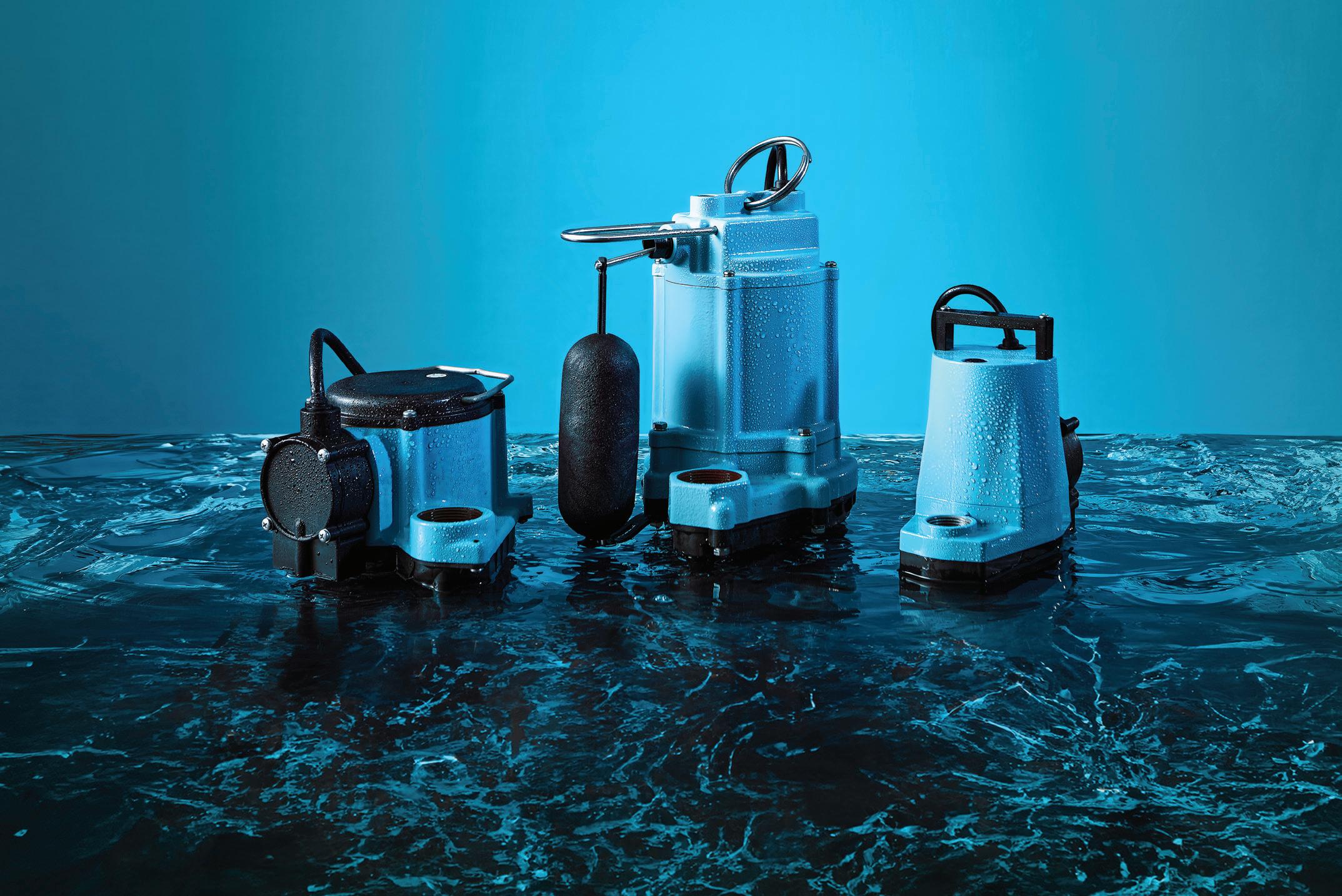

Gas venting systems have evolved over the years with improved solutions for every situation.
BY IAN MCTEER
Once our ancestors realized waiting for the next lighting strike to start a forest fire was not the best way to plan for meal preparation, the desire to start a fire when needed and to control the consequences of that fire started in earnest.
Cave dwellers likely noticed some caves filled with smoke while others had the smoke carried away by natural ventilation—some people have all the luck. Having a source of heat was highly desirable, the smoke, not so much. For the longest time, our ancestors had to put up with both.
Around 600 B.C., the Greek historian Herodotus described yurt-like tents
used by people in Central Asia. The yurt (or Mongolian Ger) was a conical shaped structure covered with felt or animal skins. Inhabitants could build small fires inside and vent the smoke through an opening in the roof called the toono. Similarly, Indigenous peoples in North America devised a conical structure with a smoke flap at the top providing ventilation built in the centre of the structure of the teepee (or tipi). By the 2nd century B.C., the Romans had developed an underfloor heating system that circulated heat and smoke from a rudimentary furnace through an open space beneath the floor supported by stone pillars. The heated air and smoke
would then vent upwards and out through flue passageways in the walls while also heating upper rooms in the process. Genius.
Someone finally noticed that if a vertical chase or tube of sufficient height is placed over a fire, then the smoke (and a lot of heat) magically disappears up the tube and exits at the top.
In Europe, by the mid-15th century, chimneys and fireplaces were in general use. However, fireplaces burning extraordinary amounts of wood fuel created seemingly hurricane force drafts
Continued on p58




HIGH-EFFICIENCY CENTRAL HEAT PUMPS WITH CASED COILS
Heat pump combination AHRI Certified for installation with ANY 3rd party furnace.


COLD CLIMATE DC INVERTER HEAT PUMP
Two-stage, two-cylinder compression and hot gas injection for unparalleled heating efficiency.
Eligible for financial incentives in certain provinces, contact us for more detail.
TO FULLY SUPPORT OUR DEALER NETWORK
OFFICIAL DISTRIBUTOR IN CANADA
*GREE Canada is not responsible for warranty on units sold outside GREE Canada’s sales channel.
For more detail, contact our team at proservice@gree.ca




forcing lords and ladies to hurry the invention of high-backed chairs, thus preventing chilly winds from freezing their backsides (while simultaneously roasting from the radiant heat in front).
Then came free-standing vented stoves in the 18 th century, possibly modeled after the ancient Chinese brick stoves that retained heat long after the fire had become a bed of embers.
Today’s fossil-fueled appliances depend upon an engineered balance of access to adequate combustion air while exhausting the products of combustion in such a way that the flue products are purged of as much useful heat as possible.
Metal and masonry chimneys safely continue to serve residential, institutional and industrial applications every day and will continue to do so long into the future.
Of course, all chimneys must be professionally designed, professionally installed, regularly inspected and maintained.
And, like just about everything else, chimneys can fail with disastrous results in the absence of all of the above. Regardless of the reason, when a chimney stops working, lives are at risk.
Chimneys typically stop working because the flue passageway is obstructed by something, perhaps a broken tile, or a critter stuck inside, or even a build-up of soot or other debris. That is why yearly inspection is mandatory.
Another major reason chimneys fail has more to do with the poor quality of the draft necessary to support buoyancy. And this issue, residentially speaking, too often became a problem when many homeowners enthusiastically sealed-up their houses so tightly that flue products would spill back into the house.
In a worthwhile but inconsistent effort to save energy, insufficient knowledge and planning led to premature failure and replacement of otherwise perfectly operational fossil-fueled
heating appliances in the least case and, in the worst case, death by carbon monoxide poisoning.
Such potentially existential contradictions cannot stand; nevertheless, the introduction of mid-efficient 80% AFUE appliances often robbed chimneys installed in cold climates of the number one ingredient they need to work: heat.
Waste heat from pilot burners combined with conditioned air escaping through the draft hood of buoyancy vented appliances installed in leaky older houses helped to maintain some warmth in the chimney ensuring a reliable draft. But retrofit with a mid-efficiency furnace, seal up the house, make the furnace compete for combustion air with other air exhausting appliances such as clothes dryers, gas stoves, water heaters, range hoods, and central vacuum systems and the chimney draft often goes away.
Additionally, tile-lined masonry chimneys installed on the outside of the building are prone to internal condensation. When a fossil-fueled appliance starts a combustion cycle, the chimney may have cooled considerably. During this period, the water vapour produced by combustion can condense on the cold surfaces of the chimney. This condensation period is referred to as “wet time.”
Prolonged condensation can lead to issues such as corrosion and the buildup of acidic residues in the chimney. Once the chimney warms up sufficiently, the water vapour remains in a gaseous state and is expelled, reducing the risk of condensation-related problems. A rusted chinmey dampner (see Figure 1) could be a tell-tale sign of a serious condensation problem: cold chimney, oversized flue, under firing or a combination of effects means buoyancy venting needs a serious reevaluation.
By the early 2000’s, Canada’s B149.1 Code had been thoroughly revised reflecting advances made in gas appliance and building technology. Appendix C of the new code introduced
System XFR® pipe and fittings deliver all the performance advantages you would expect from thermoplastic piping.
Read our Case Study “IPEX DWV Stands the Test of Time”
ipexna.com

tables meant to account for fan assisted and natural draft appliances to be installed in applications where negative pressures up to 5 Pascals (Pa) might be caused by air exhausting appliances.
Four appliance categories were established with Category I reserved for Natural Draft and Fan Assisted types. One key direction of the updated code specified anyone wanting to install a Category I appliance (defined as an appliance that operates with a nonpositive vent static pressure and with a flue loss not less than 17%) must check building airtightness and depressurization beforehand.
The water heater in Figure 2 (previous page) shows signs of wet time spillage even though it may have a solid draft. Said draft must be strong enough even while all other air exhausting appliances are in operation in the home.
The 2005 version of the B149.1 code made it clear that buoyancy vented gas appliances (Category 1) should not be installed in a building until its airtightness and depressurization status could be determined.
Since direct vented furnaces, defined as Category IV (an appliance that operates with a positive vent static pressure and with a flue loss less than 17%), were well established in the marketplace by that time, the so-called high efficiency furnaces became the installation choice of many contractors.
The approved vent system became known as a Special Venting System and was to be installed according to the manufacturer’s certified installation instructions.
At the time, manufacturers specified plastic vent material of ABS (Acrylonitrile butadiene styrene), PVC (Polyvinyl Chloride), and CPVC (Chlorinated



Polyvinyl Chloride) material. The installation manual required those wanting to use ABS material to use ABS Schedule 40 DWV (drain, waste, vent), meeting ASTM D2661 equivalent to CSA B181.1.
Power vented Category III water heaters (operating with a positive vent static pressure…flue loss not less than 17%) were approved for ABS material as well. But, wouldn’t you know it, there was a
problem — actually several problems. ABS plastic vent pipes started cracking, poorly trained installers often failed to assemble the material properly causing pipes to come apart, and the plastic pipe manufacturers became alarmed that our industry used their materials in untested and unapproved situations. Those situations included producing potentially higher temperatures than
tested for, more vibration, acidic condensate and gas-fired appliances could even be passing raw natural gas or LP in small quantities from time to time—say after several failed trials for ignition.
A more robust standard for plastic venting materials was developed in the late 90’s and material manufactured to that standard became mandatory some years later.
PVC meeting ULC S636 Class IIA certified for use with flue gas temperatures up to 149F (65C) and CPVC meeting ULC S636 Class IIB certification and certified for use up to and including 194F (90C) must be used appropriately with today’s Category III and Category IV products. These certified products, like the System 636 series from IPEX for example, meet these modern demands.
Starting to work with plastic venting systems back in the ‘80’s, I was never fond
of being exposed to the use of mandatory cleaning and bonding agents. Instructions directed users to apply the agents in a well-ventilated area; except that too many basements are the antithesis of well ventilated.
“A more robust standard for plastic venting materials was developed in the late 90’s.”
Dry fitting and measuring for angles so that the vent system maintained an adequate slope, and then hurrying to fit everything with rapidly curing adhesive threatening to aim elbows at the stars— especially in confined spaces—too often

We at Multi-Glass Insulation LTD. are dedicated to constantly improving and growing our product lines. We are proud to announce our own flagship EPDM rubber insulation products available in sheets, rolls and pipe insulation available with self seal laps or unslit. Available now.
made the vent installation process a challenge.
IPEX recommends installers receive formal training on their system every three years to ensure proper installation methods are used at all times.
I first became acquainted with polypropylene vent systems at the 2012 CMPX show, (see Figure 3). This lightweight material has several desirable benefits for HVAC contractors.
Two lines I became aware of, including the Centrotherm InnoFlue and Duravent PolyPro, consist of material suitable for U.S. Category II and IV or Canadian Type Gas Vent BH, Class II heating equipment with a gas-fired max. flue gas temperature of 230F (110C) or an oil-fired max. flue gas temperature of 248F (120C).
Another product on the market includes the Z-Dens brand vent systems from Flexmaster, a relationship with
Continued on p62

You asked and we listened and have partnered with Tremco to offer the best fire stopping product for your self level and gun grade needs available in 600ml sausage tubes and 17L pails.
Ask your local team for more information on any of these new additions to our product lines. We are here to help you grow.

Contact your account rep. or our customer service: csr@multiglass.com WWW.MULTIGLASS.COM


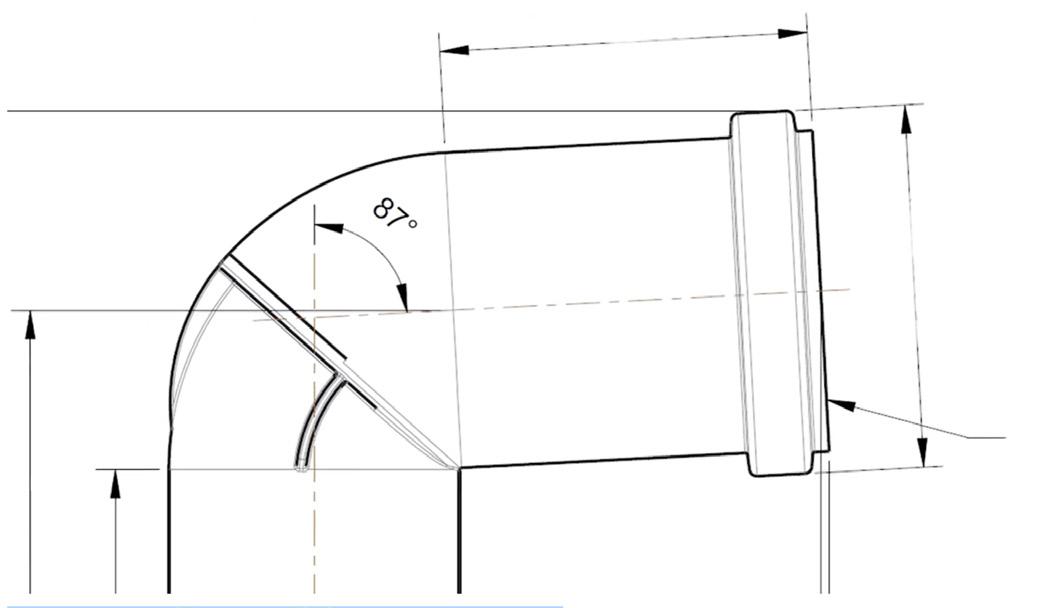

The 87-degree elbow automatically facilitates a ¼-in. per foot slope (1-degree slope) when using up to 6-in. material in a horizontal application.
Dutch-based Cox Geelen, a European manufacturer of polypropylene venting systems.
Appliance types with these flue gas temperatures include condensing boilers, furnaces, tankless water heaters and tanked water heaters. Contractors must be sure to check the vent manufacturer’s lists of equipment approved to use polypropylene materials, and (like the PVC or CPVC venting pipes) sign-up for training to learn appropriate specifications and installation designs and techniques.
Imagine my delight to discover no chemical cleaning or bonding agents (other than a chemical known as water) were needed to join the polypropylene pipe and fittings.
The integrated gasket systems also allow for post installation adjustments and the heating equipment can be fired immediately as no cure time is required.
Fittings and pipe are held together by an S636 compliant locking clamp, yet the joints can be taken apart and reconnected, as necessary.
A flex kit is available for vertical vent situations such as through an unused chimney, B-Vent or other suitable vertical chase.
I discovered that Centrotherm offers a wide variety of elbows in 2-in. to 12-in. material: 15-, 30-, 45- and 87-degree elbows to suit a diversity of installation challenges. The 87-degree elbow automatically facilitates a ¼-in. per foot slope (1-degree slope) when using up to 6-in. material in a horizontal application. This is an important feature as a proper slope is essential to ensure condensate removal from the vent system.
It also helps to stress-relieve the vertical section of pipe coming off the appliance cabinet and, in my opinion, helps to reduce premature failure of the draft inducer and collector box.
I used the PolyPro material for the venting of my own gas furnace in 2014. Other than the first-generation clunky locking clamps, the material was a pleasure to work with. I especially liked the concentric vent terminal, easily installed and worked beautifully in the coldest weather (see Figure 4).
Compared to the initial offering of polypropylene vent materials I saw at the CMPX show over a decade ago, there are now an abundance of available products and accessories. Small diameter, single wall systems work in approved applications up to 6-in.; large diameter, single wall materials for applications up to 12-in., flex kits for chimney lining and a concentric system featuring polypropylene inner pipe enclosed by a white, powder coated welded aluminum outer pipe in sizes up to 6-in. material.
In commercial applications, the single wall vent system can be used with ANSI Category II and IV appliances, and is designed to handle condensate management, cascading or common venting of multiple high-efficiency water heaters, condensing boilers and 90+ furnaces. Centrotherm’s InnoFlue Single Wall Commercial can be used with natural gas, propane and oil fueled appliances with maximum flue gas temperatures of 230F (110C).
In conclusion, there are many venting choices for today’s gas-fired appliances. Depending on the maximum flue gas temperatures installers can be choosing from single-wall or double-wall stainless steel to various tried and tested plastics. Of course cost is always a consideration.
One factor not often thought about is end of life disposal. Polypropylene is recyclable, as are metals.
I’ve personally found polypropylene vent material to be durable and efficient, but always before connecting piping to any appliance follow the manufacturer’s instructions, get trained on the products where available, and take steps to ensure you select a solution that fits your customers’ long-term needs. <>

Ian McTeer is an HVAC consultant with over 35 years of experience in the industry. He was most recently a field rep for Trane Canada DSO. McTeer is a refrigeration mechanic and Class 1 Gas technician. For more information, Ian can be reached at imcteer@outlook.com.



Our HVAC products have been designed on a foundation of excellence, with a selection of advanced Gas Furnaces, Central Air Conditioners, Central Heat Pumps, Air Handlers, and Thermostats. Each one of our HVAC products incorporates the latest cutting-edge and energy-efficient technologies to help your customers enjoy each day in total comfort while optimizing their energy use.
Like everything Continental designs and builds, each unit is exceptionally easy to use and install, and designed to last a lifetime.

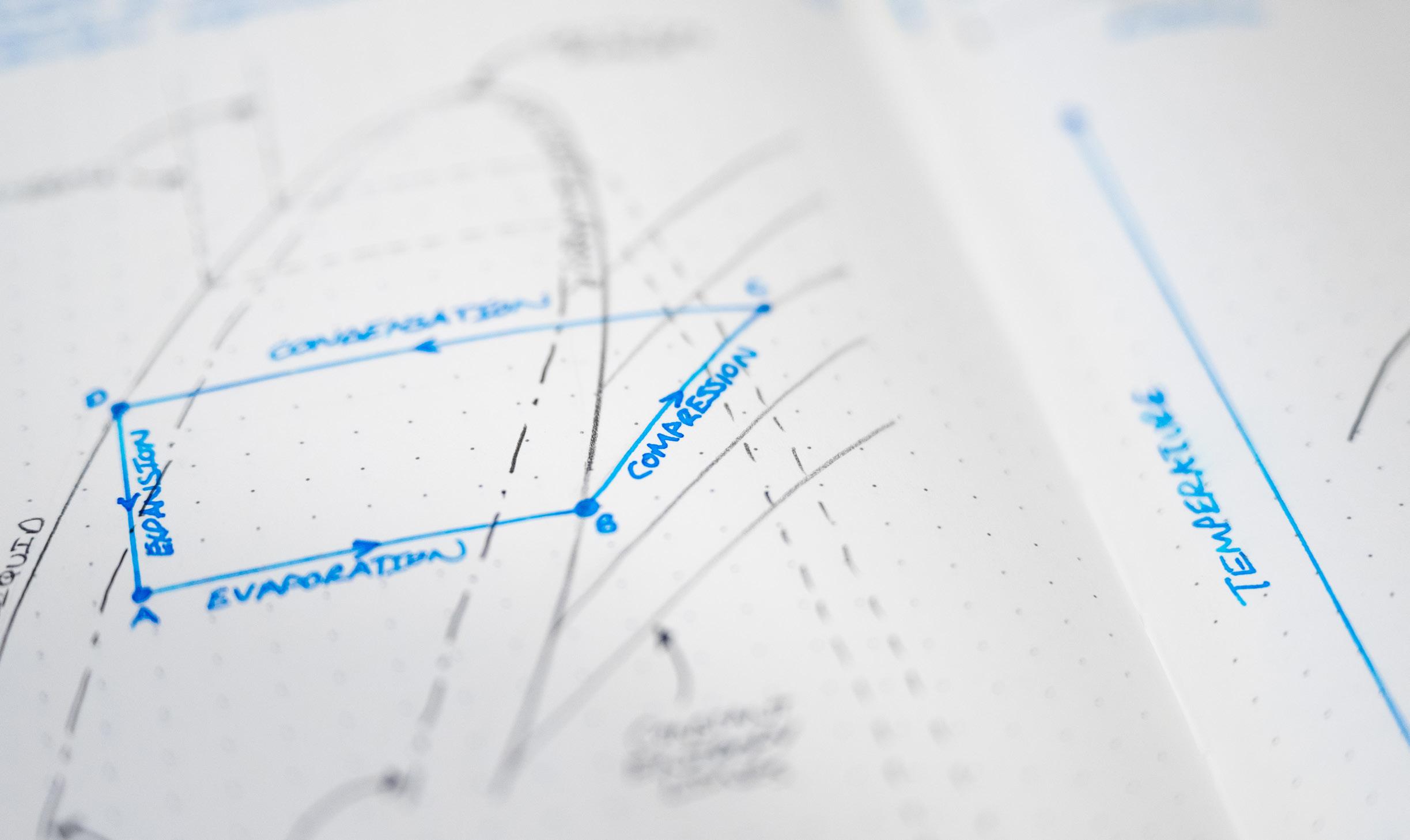
Understanding and appreciating the relationship between these two conditions in the refrigeration cycle is music to this writer’s ears. BY DAVE
DEMMA
The year of 1983 saw the release of the movie Eddie and the Cruisers. It was a complete box office flop, but the flic has turned into a cult classic. The opening scene takes place 18 years after the mysterious disappearance of Eddie Wilson (the band’s namesake) with renewed interest in the band’s debut album. There are several flashbacks of the group’s origins, including their start in a Somers Point, New Jersey club named Tony Mart’s.
Eddie is not particularly adept at writing lyrics, so he hires Frank Ridgeway, aka “Wordman”, to be the band’s keyboard player and lyricist. In another flashback, Wordman is singing what was to become the band’s signature hit “On the Dark Side”… not the up-tempo rocker version that would become a top 10 hit, but as a very slow and sappy ballad. The band members are laughing at the attempt, but as he finishes Eddie says, “Not Bad.”
And then Doc, the band’s manager, chimes in, “Not Bad? The kid can’t play, he can’t sing, and he can’t write. So, what’s not bad?”
And Eddie replies, “He’s got somethin’ we need.”
”Like what?” asks Doc.
“Words and music, Doc. Words and music.”
If we were reviewing the chronicles of Dave and the Refrigerant Techs, we’d find that the “somethin’ we need” is pressure and temperature. Without out those two key pieces of information, it’s near impossible to properly diagnose how the refrigeration cycle is performing.
Sure, there are some techs who go by the old adage: “If the suction line is beer can cold, the expansion valve must be set correctly.”
But what is the precise definition of beer can cold, and how many individuals can correctly detect an accurate temperature by feel?
One apparent truth in our physical world is that matter can exist in one of three states: solid, liquid or vapour.
Some definitions that apply to those phases are as follows:

Latent Heat of Fusion: amount of heat required to change a mass of material from the solid phase to the liquid phase.
Latent Heat of Vapourization: Amount of heat required to change a mass of material from the liquid phase into the vapour phase.
Sensible Heat: Heat that is ab -
sorbed/rejected by a material which results in a change of temperature.
Latent Heat: Heat that is absorbed/ rejected by a material which results in a change of physical state. This change occurs at a constant temperature.
Saturation Temperature: That temperature at which a liquid starts to boil,
or a vapour starts to condense. The saturation temperature is a constant at a given pressure, and will increase/decrease as the pressure experiences an increase or decrease. A liquid cannot be raised above its saturation temperature. Whenever a fluid is present in two states (liquid and vapour), the mixture will be at the saturation temperature.
Superheat: At a given pressure, the difference between a vapour’s temperature and its saturation temperature.
Subcooling: At a given pressure, the difference between a liquid’s temperature and its saturation temperature.
The graph in Figure 1 illustrates some of these definitions, using water as the medium experiencing a heat transfer process. This graph plots the water temperature versus the enthalpy of the water (heat content in Btu/lb). Water boils at 212F (atmospheric pressure at sea level).
Continued on p66



By definition, water at atmospheric pressure at a temperature lower than 212F is subcooled.
So, we start with subcooled water at 32F and begin transferring heat to it. Assuming we are working with 1 lb. of water, for every Btu added a corresponding temperature increase of 1F will be achieved (the definition for one Btu).
If we continue to add heat, eventually the water’s temperature will increase to 212F (the saturation temperature at atmospheric pressure). At this point, the water begins to change states from a liquid to a vapour (boil).
As noted on the graph, the water will experience no further temperature increase. For a given pressure, the saturation (boiling) temperature is the highest temperature a liquid can ever achieve. Increasing the amount of heat transferred to the water simply increases the rate at which the water boils. If the temperature of the vapour were to be measured, we’d find it to be 212F (saturated vapour).
Once the vapour has separated from the liquid, additional heat transferred to it will result in a temperature increase. By definition, the vapour at 232F (20 degrees above the saturation temperature), is superheated.
Point 1 (the red box with the 1) on the graph illustrates the sensible heat transfer process, with the resulting increase in the liquid’s temperature. Point 2 illustrates a latent heat transfer process, with the liquid undergoing a change of state into a vapour. Point three illustrates another sensible heat transfer process, with the resulting increase in the vapour’s temperature.
The liquid subcooling is calculated by measuring the difference between the saturation temperature (212) and the actual liquid temperature (32), which results in 180F subcooling. The next time you’re drinking a cold bottle of water, you can now impress those in your pres -


ence by stating that you’re drinking subcooled water. The superheat is calculated by measuring the difference between the saturation temperature (212) and the actual vapour temperature (232), which results in 20F superheat.
So, how are these principles, definitions and calculations applicable to determining whether a system is operating properly? Figure 2 shows a typical vapour compression cycle, common in most air conditioning and refrigeration systems. The basic system is as follows:
• 100% vapour enters the compressor inlet (suction) at a relatively low pressure.
• The compressor “compresses” the vapour to a higher pressure. In the process, heat is added to the refrigerant, which results in a high temperature (superheated) high pressure vapour.
• The vapour enters the condenser where heat is transferred to the condensing medium (water or air). This results in a phase change (vapour to liquid). Depending on the size/condition of the condenser, liquid might experience some subcooling too.
• 100% liquid exits the condenser and flows to the expansion device. Here, the liquid undergoes a pressure drop. The ex-
pansion process results in a mixture of liquid and vapour at the expansion device outlet, meaning that the liquid is now at a saturated state. This low-pressure liquid is at a lower temperature (the saturation temperature corresponding to the new pressure).
• The mixture of saturated liquid and vapour enters the evaporator. Heat from the warm air in the refrigerated space is transferred to the saturated refrigerant, which results in the saturated liquid boiling. At some point the last molecule of liquid boils into vapour. Further transfer of heat from the warm air in the refrigerated space to the refrigerant vapour causes an increase in the vapour temperature, resulting in superheated vapour at the evaporator outlet.
In addition to understanding the principles discussed above, along with the dynamics of refrigerant flow and state in the vapour compression cycle, another piece of information is required—the corresponding saturation temperature at a given pressure for the specific refrigerant used in the system being considered.
Figure 3 shows a snippet of a common Pressure-Temperature (PT) chart. The two red circles indicate that at a pressure of 15 PSIG, the saturation temperature of R-404A is -21F. Instead of looking up numbers on a chart, there are many
Continued on p68

pressure temperature apps available (Figure 4 is one example). Given that we all have cell phones, downloading this app will eliminate the possibility of never having a PT chart available. In addition, it will calculate superheat and subcooling for you as well.
Using the corresponding saturation temperature with the 15 PSIG suction pressure, now the superheat can be accurately calculated. Figure 5 shows this calculation.
“TEVs can only operate at their rated capacity if they are receiving 100% liquid at their inlet ... using a PT chart would be able to verify this.”
Why is this calculation important?
The TEV regulates the refrigerant mass flow to the evaporator, which in turn determines the amount of heat which can be transferred from the warm air in the refrigerated space.
The superheat setting should be determined by the equipment manufacturer. In the absence of the manufacturer’s recommendations, some common superheat guidelines are shown below:
Low Temperature Applications: 4- to 6-degree Superheat
Med Temperature Applications: 6- to 8-degree Superheat
Air Conditioning Applications: 12- to 15-degree Superheat
A delicate balance is required to ensure that the system is operating at peak efficiency, yet it is protecting the compressor from damage.
Ideally, a completely flooded evaporator operating at 0-degrees superheat at the evaporator outlet would provide the greatest system capacity, as it would mean that 100% of the evaporator surface is being used for effective heat transfer. However, that would put the compressor at risk of the damaging effects of liquid floodback.
Conversely, if the superheat is higher than recommended, the refrigerant mass flow through the evaporator will be less than required to maintain the desired temperature, aka, starving the evaporator.
So, the superheat needs to be as low as possible to maintain evaporator capacity/efficiency, yet it must be high enough to prevent liquid floodback.
Following are a few other conditions that can be detected by using the PT chart/app.
TEVs can only operate at their rated capacity if they are re -

ceiving 100% liquid at their inlet. Another instance of using the PT chart/app for system analysis would be to verify whether this is actually occurring.
Some amount of subcooling is necessary at the TEV inlet to ensure that the refrigerant is not at a saturated condition. Another pressure and temperature measurement and the corresponding calculation to determine the amount of subcooling, can provide that verification.
Another condition which would result in an inability to maintain the desired refrigerated space temperature would be a partially plugged liquid filter-drier. The resulting reduction in refrigerant flow would lead to an underfeeding TEV and a loss of system capacity. A quick check of the pressure and temperature at the filter-drier outlet would reveal whether the refrigerant is subcooled at the filter-drier outlet, which would maintain the 100% liquid feed to the TEV.
Compressor life can be shortened by overheating. Certainly, a dirty condenser can lead to higher operating temperatures. High suction vapour temperature will also result in elevated operating temperatures. In fact, every 1F increase in suction vapour temperature will yield an approximate 1F increase in discharge temperature.
High TEV superheat along with lengthy suction piping runs with ineffective/missing insulation are both contributors to high suction superheat.
While typically a minimum 20F is recommended to ensure against liquid floodback at the compressor inlet, elevated suction superheat should be avoided.
As a final note, when I worked for a flow control manufacturer it was not uncommon to attend trade shows for technicians. These shows were typically sponsored by wholesale distributors.
At one memorable event, a technician came to my table that was covered with displays and picked up a PT chart. He studied it for a moment, scratched his head, then asked a very revealing question: “What is this for?”
My reply: “Can I ask, how long have you been in the trade?”
His response: “About eight years.” I went on to explain the purpose of the chart, and how it could be used for system troubleshooting.
He left my table with a somewhat bewildered look on his face, revealing that he didn’t understand too much of what I shared.
I was saddened to see that someone who had been in the trade for that

length of time was missing a fundamental grasp of the principles of the trade he was employed in.
When I have discussions with technicians who do possess a firm understanding of refrigeration principles and who get the importance of the pressure-temperature relationship and its relevance in system troubleshooting…well, those are welcome words and music to my ears. <>
Adrian Steel ....................NewEra.AdrianSteel.com .................. p.12
Affiliated Distributors adhq.com p.43
AHR Expo ........................ahrexpo.com ...................................... p.71
AO Smith hotwatercanada.ca p.37
Aqua-Tech .......................aquatech-canada.com ...................... p.19
Bradford White forthepro.bradfordwhite.com p.72
CB Supplies ....................cbsupplies.ca .................................... p.25
Chemfax chemfax.com p.2, 3
Conforto ..........................confortohvac.com ............................. p.28
Continental continentalcomfort.com p.63
Dettson ...........................dettson.com....................................... p.17
ecobee ecobee.com/contractor p.13 Franklin Electric ............littlegiant.com.................................... p.55
General Pipe Cleaners drainbrain.com/XPodPlus p.5
Gree Canada...................gree.ca ............................................... p.57 HALO Water halowater.com p.39 Intertek

Dave Demma holds a degree in refrigeration engineering and worked as a journeyman refrigeration technician for years before moving into the manufacturing sector where he now regularly trains contractor and engineering groups. For more information Dave can be reached at ddemma@uri.com.
October 21-23
This edition of the Decarbonization Conference will be held in New York City and will focus on an information and idea exchange on topic of reducing carbon emissions from existing tall buildings in cold climates.
ashrae.org
December 4-6
Taking place at the Metro Toronto Convention Centre, South Bldg., this event includes Contruct Canada, Homebuilder & Renovator Expo, PM Expo and World of Concrete under one roof. The event is part of Canadian Real Estate and Construction Week in Toronto. thebuildingsshow.com
March 11-13
The International Ground Source Heat Pump Association (IGSHPA) is holding its annual conference in a dedicated conference center at the I Hotel in Champaign, Illinois. Breaking New Ground is the theme of this year’s event. igshpa.org
April 24-25
Biennial HVAC and plumbing event held in Montreal and produced by the Canadian Institute of Plumbing & Heating and Corporation of Master Pipe-Mechanics of Québec, returns to the Montreal Congress Centre. mcee.ca

October 22-24
A trade show and conference featuring the latest in products and services, KBC 2024 takes place at the International Centre - Hall 5 in Toronto. The event is a destination for exhibitors and attendees to learn about current industry trends and discover showcased products. kbcexpo.com
February 10-12
The 2025 edition of North America’s largest tradeshow and conference travels to the Orange County Convention Center in Orlando. The AHR Expo brings together manufacturers and suppliers of all sizes and specialties to share ideas and showcase the future of HVAC/R technology. ahrexpo.com
March 17-21
Hosted in Frankfurt, Germany, ISH is the flagship international event for the plumbing and HVAC sector. With a theme of “Solutions for a Sustainable Future” visitors will gain insights on where the industry is headed as manufacturers from around the world display the latest in modern innovations. ish.messefrankfurt.com
May 24-26
The Canadian Apprenticeship Forum (CAF), is producing the Supporting Equity in Trades Conference, being held at the Westin Harbour Castle in Toronto. The event will attract industry leaders, advocates, and allies to promote equity and inclusion in Canada’s skilled trades. caf-fca.org
November 27-30
The Mechanical Contractors Association of Canada takes its annual national conference to the capital city of Texas, Austin, which is well known for its live-music scene centered around country, blues and rock. mcac.ca
February 25-27
The largest kitchen and bath industry show in North America showcasing thousands of products from over 600 brands in the residential design space returns to the Las Vegas Convention Center. Plumbing contractors will uncover the latest trends at this show. kbis.com
March 24-27
The Air Conditioning Contractors of America is the national trade association furthering the interests of HVAC/R contracting businesses and the broader HVAC/R industry. The ACCA Conference is taking place at the Kalahari Resort near Austin, Texas. accaconference.com
CIPH Annual Conference
June 29-July 1
The Canadian Institute of Plumbing and Heating annual business conference is taking place at the Fairmont Tremblant, in Mont Tremblant, Quebec. Senior executives from major manufacturers, distributors and agents will gather for networking and educational sessions. ciph.com
“ It’s good to be proactive rather than reactive. You have to go find out what’s out there, get outside of your role and your company and see what other people out there are doing.”
Level up at the event for HVACR.
FEBRUARY 10-12, 2025




Choosing the ideal tankless gas water heater for the job is easy with Bradford White. Our Infiniti® GS and GR models are ready for anything with a robust and flexible design that contractors love.
• Residential and Commercial applications
• Robust stainless steel heat exchanger for longer life
• Cascade and common venting between standard and recirculation models
• ENERGY STAR® certified and Certified Green Product™ by the Green Restaurant Association
